
161 minute read
Ons stel bekend: Lt.kol. P Malherbe
Philip Malherbe
Kwalifikasie:
Advertisement
hatswana, wat later deel gevorm het van NoordWas die Potchefstroom Universiteit behulpsaam met ʼn navorsing program om ʼn slagoffer bystand ondersteunings basis op die platteland (vorige Bophuthatswana, daarna by Noord-Wes Provinsie ingelyf) tot stand te bring. Jeug Ontwikkeling (Provinsiale Bevelvoerder Noord -Wes Provinsie: 1997 -2004) en het na die WesKaap die tweede meeste Misdaad Voorkoming Lesings by skole aangebied.
As Provinsiale Bevelvoerder van Sosiale Misdaad, die eerste Projek Bestuurder van twee projekte (buitelandse befondsing) (Slagoffer Bystand Vesting & die Brandmerk van vee) in (2003 -2004) die Nodale Punte van die Gesamentlike Geïntegreerde Volhoubare Plattelandse Ontwikkeling Program bestuur het. As Provinsiale Bevelvoerder, van Gyselaaronderhandeling tesame met die Nasionale Bevelvoerder van Gyselaaronderhandeling, ʼn B.Tech. Polisiëring (NQF vlak 8 = 4 jaar, berg (Sun City) Internasionale Lughawe vir gelykstaande aan Hon.) Buitelandse Besoekers opgestel. 1996 - Provinsiale Projekbestuurder van Bestuurs- Word saam met al die ander Provinsiale Beveldienste verantwoordelik vir die eerste Sosiale voerders van Gyselaaronderhandeling genomineer Veiligheid Gemeenskap Projek (buitelandse om ʼn Teen-Terroriste-program in Gyselaar Onderbefondsing) (een stop, veeldoelige fasiliteit - alle handeling (US Departement of State Diplomatic regeringskantore en besighede sentraal in ʼn dorp Security te Louisiana State University) te deurloop (Tshidilamolomo gesetel in vorige Bophut- in 2000. Sekuriteitsplan teen Vliegtuig Kaping te PilanesWes Provinsie) – waar 15 rol spelers van Woon ook saam met die ander Provinsiale regerings departemente verteenwoordig is. Gyselaar Bevelvoerders uitgenooi om die 2de Internasionale Gyselaar Onderhandeling WerksOpleiding van Gemeenskap Polisiëring Forums groep Konferensie (1 week) in SAPD Speur(Provinsiale Bevelvoerder Noord-Wes Provinsie - akademie te Pretoria, by te woon in 2001. 1997 -2004). Kry ʼn toekenning van die Noord-Wes Minister van Polisie vir ʼn Evalueringsproses van Verskaf Opleiding van polisielede (Gasdosent te Gemeenskapspolisiëring Forums in die Noord-Wes Polisie-opleidingskollege te Paarl en Graaff-Reinet) Provinsie – hierdie Evaluering Proses is later deur Kursusse deurloop Nasionaal by al die Provinsies geïmpliseer. Kursusse Word uitgenooi om die 5de FBI Internasionale Opleidingsessie vir Polisielede in Afrika (Kaapstad) (1 week) by te woon. Teen-insurgensie van Terroriste (drie keer (‘74 & ’75, in ou Rhodesië grensdiens verrig te Kendeya, Manapools en Kanyemba) Sosiale Misdaad Voorkoming (Provinsiale Bevel voerder Noord Wes Provinsie -1997 -2004) Veiligheidstak Opleiding Slagoffer Bystand (Provinsiale Bevelvoerder Noord Wes Provinsie: 1997 -2004) BBP (Baie Belangrike Persone: gewoonlik parlementslede) beveiliging (Continued on page 64)
Gevorderde BBP Beveiliging - Voertuig Hantering Ontplofbare Stowwe en Geprakseerde Ploftoestelle (Plofstof Bevelvoerder op Veiligheidstak Soweto ’80 – ’83 (word as A/O (terwyl Johannesburg se VT oor ʼn luit en kapt, beskik, deur WWR, PG, Adv Klaus von Lierus Und Wilkau versoek om sy aanklaers (advokate) in die hooggeregshof te kom toespreek rakende terroriste- wapens en plofstowwe) en & SWD Plofstof Bevelvoerder ’85 tot ’92) Gevorderde Hantering van Onderhandeling en Konflik Vaardighede Ontwikkeling van Gemeenskap Polisiëring Nasionale Trauma Ontlonting Verbetering van Dienslewering SDIP Fasilitering Speurder Kursus vir Offisiere
Forensiese Kursus vir Ondersoek Beamptes
“Heli-Bucket Fire Fighting” dienste Raad) (Suid-Kaap Streek-
Assessor Ontwikkelingsprogram (ETDP-SETA) (Germiston) Moderator Ontwikkelingspogram (ETDP-SETA) (Germiston)


Dr Jane Buys
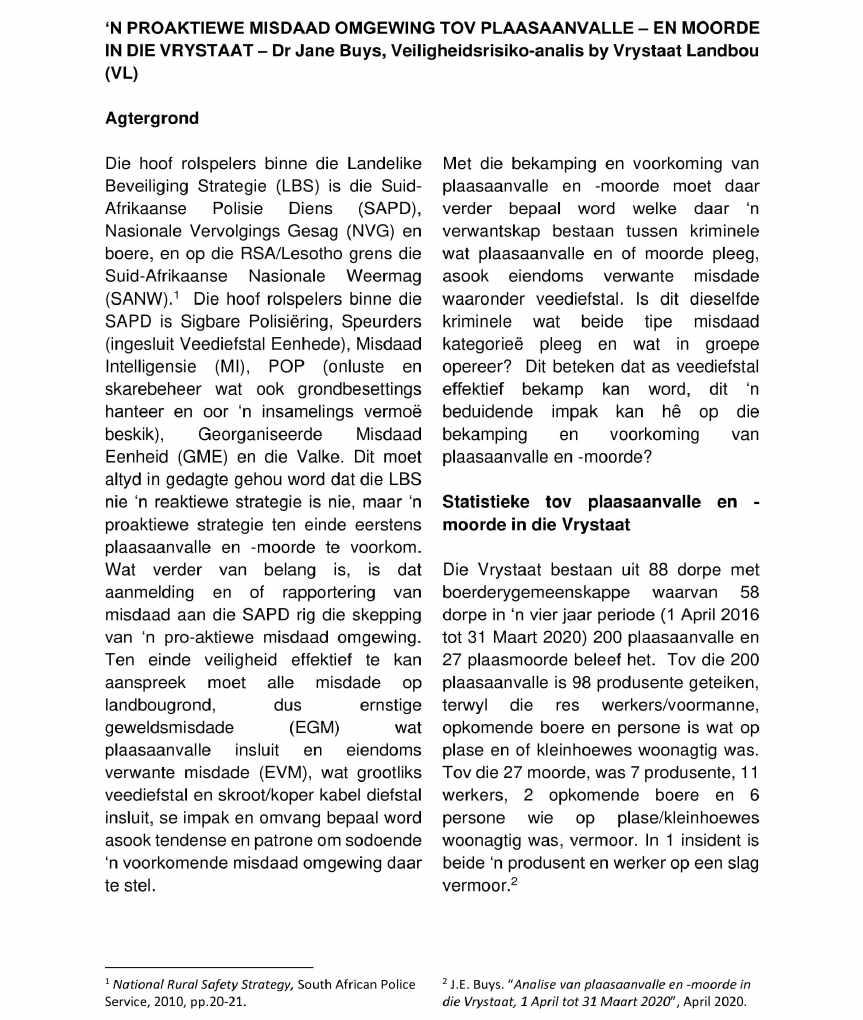

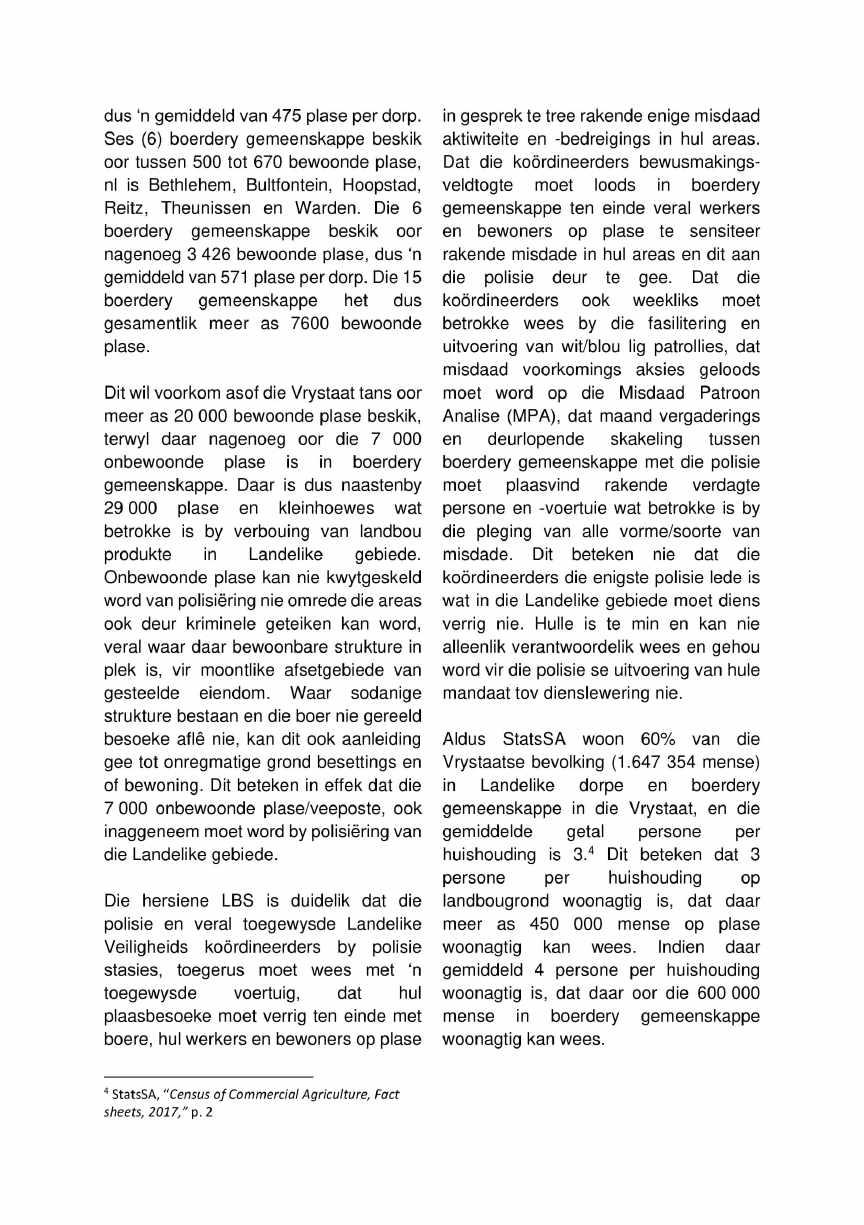






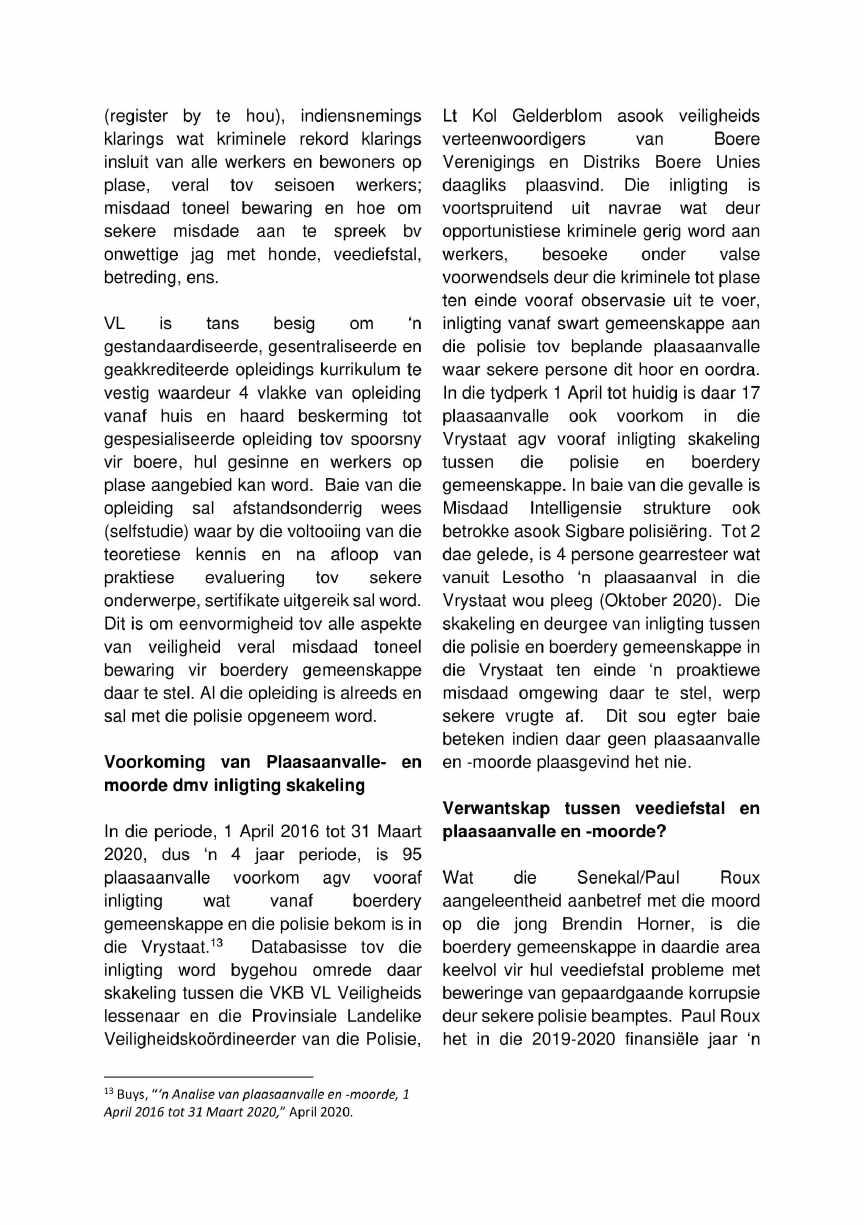


Die polisie te Augrabies
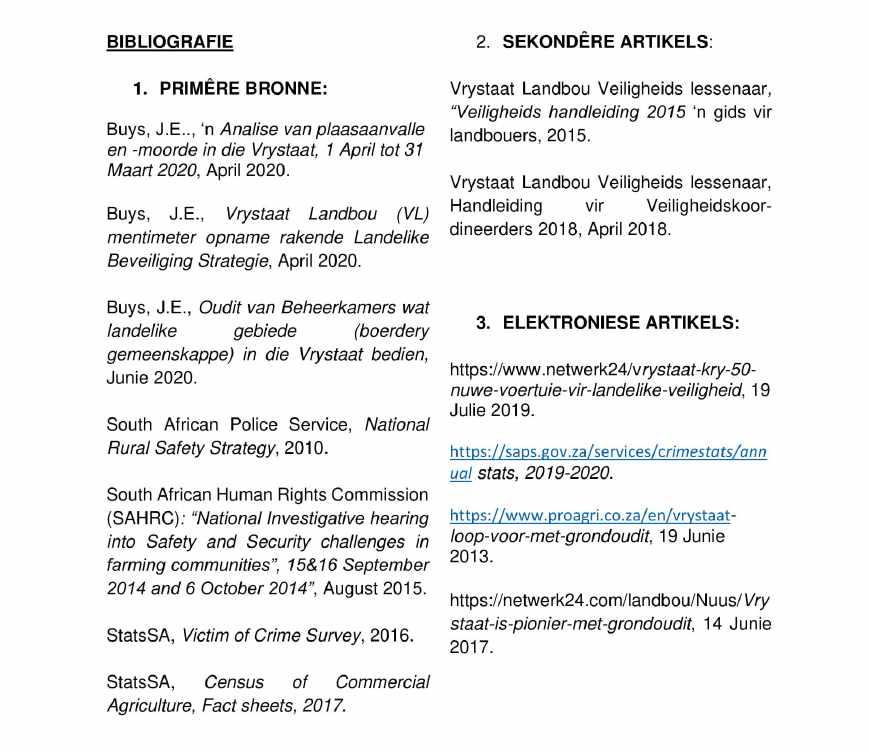

Kol Langenhoven (Bloemfontein)
Bevelvoerders van die SAP se Veiligheidstak

Historiese foto. Van links na regs: Lt-genl SJJ “Basie” Smit, genl-maj FMA “Frans” Steenkamp, genl JV “Johan” van der Merwe, lt-genl PJ “Tiny” Venter, genl (adv) DA “Daantjie” Bester, genl MCW “Mike” Geldenhuys en lt-genl (dr) HS “Stanley” Schutte. Genl Van den Bergh was die eerste hoof van die “moderne” veiligheidstak met adv BJ Vorster as justisie-minister. Genl Venter, ’n troepmaat, het hom opgevolg as veiligheidshoof. Lt-genl (destyds brigadier) Kobus Visser was ook vir ’n kort tydjie BO van Kompol x302 en hy is skielik opgevolg deur brig MCW Geldenhuys van die buro vir staatsveiligheid in “opdrag van sy edele die eerste minister en polisieminister”. Genl DA Bester was reeds gedurende die tweede wêreldoorlog ‘n speurder-sersant in die Spesiale Afdeling met lt.kol. JJ Coetzee as bevelvoerder. Hy was nie deel van die “nuwe orde” van genl Van den Bergh nie. Genl CF Zietsman nie op foto.
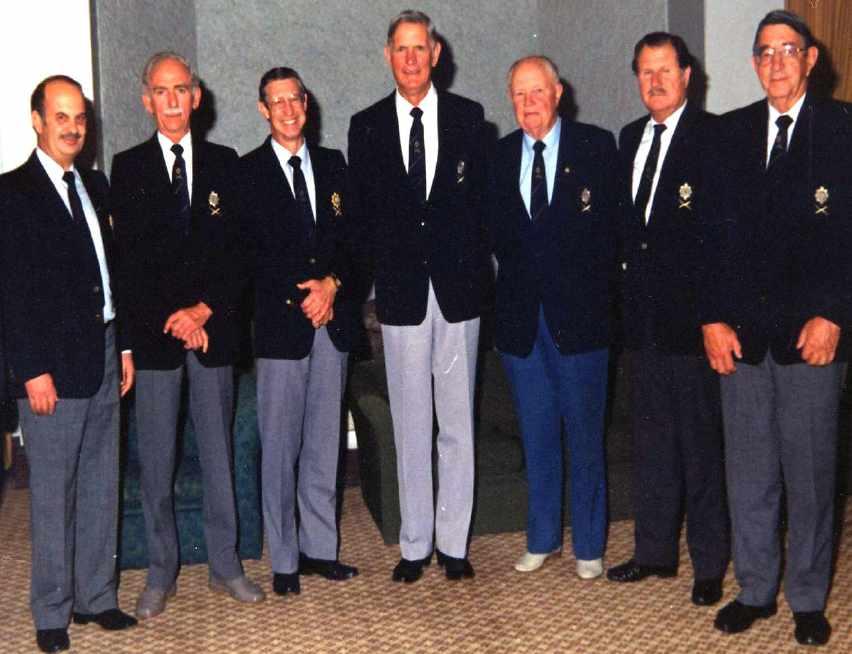
ONDERSTEUN ASSEBLIEF DIE NONGQAI TRUST
ANC Statement Statement of the ANC on the 49th Commemoration of the murder of Isithwalandwe Seaparankwe and Ahmed Timol For Immediate Release 26 October 2020

On 27 October 1971, turned to South Africa in 1970 to set up underAhmed Timol (3 No- ground structures of the ANC and SACP. Ahmed vember 1941 – 27 Oc- Timol was arrested a year later with student, tober 1971), who was Saleem Essop, severely tortured, until his brutal detained five days earli- killing on 27 October 1971, seven days before his er by the apartheid re- 30th birthday. gime, was flung to his The regime claimed he committed suicide, but all death from the 10th evidence pointed to the contrary, and his case floor of John Vorster served before the Truth and Reconciliation ComSquare Police station mission in 1996. Timol’s case was one of the 350(now Johannesburg odd cases, where perpetrators did not come forCentral Police Station). ward, withheld the truth and/or were refused amA school teacher who nesty, handed over to the Justice Ministry for prostaught in Roodepoort, ecution in 2003. Timol from an early age registered his rejection https://www.ahmedtimol.co.za/statement-of-the-anc of the evil system of -on-the-49th-commemoration-of-the-murder-ofapartheid through his activism. He left the country isithwalandweseaparankwe-ahmed-timol/ in 1966, and joined Umkhonto we Sizwe and the SACP. After military and political training, he re-
1966 Besoek: Ongulambashe deur Veiligheidshoofkantoor en genl Pat Dillon
Agter: Onbekend, genl Crous, brig Fred v an Niekerk en maj TJ “Rooi Rus” Swanepoel Voor: Onbekend, genl Tiny Venter, onbekend en kol Pat Dillon Heel voor: genl “Lang-Hendrik” van den Bergh

Explosives | Springstof

Lt kol Philip Malherbe
Die redakteur (brig Hennie Heymans) het op ondervermelde berig afgekom, waar rotte Magawa has been formally recognised for his work
aangewend word om plofstowwe te identifiseer, en my (as plofstofdeskundige) versoek om kommentaar te lewer.
Hero rat Magawa is awarded the animal equivalent of the George Cross for rooting out 39 landmines and other explosive devices after being trained to sniff out bombs
• Bomb disposal rat Magawa scratches the top of the ground when he detects a landmine which alerts handlers • He can search tennis court size area in 30 minutes which can take a human and metal detector up to four days • Magawa has been formally recognised for his work and been presented with a miniature PDSA Gold Medal By Joseph Laws for Mailonline Published: 00:11 BST, 25 September

miniature gold medal
2020 | Updated: 13:36 BST, 25 September 2020 and been presented with a miniature PDSA Gold Medal, the animal equivalent of the George Cross. He is the first rat in the charity's 77-year history to receive such an award.
A landmine detection rat has been awarded the animal equivalent of a George Cross for his 'lifesaving bravery'. Magawa, a giant African pouched rat, has discovered 39 landmines and 28 items of unexploded ordnance since he was trained by charity APOPO, which has 45 rats detecting landmines and 31 rats detecting tuberculosis in humans. He is the charity's most successful Hero Rat, having cleared more than 141,000 square metres of land - the equivalent of 20 football pitches. Magawa, a giant African pouched rat, has discovered 39 landmines and 28 items of unexploded ordnance since he was trained by a charity. He is pictured below wearing his He is the charity's most successful Hero Rat, having cleared more than 141,000 square metres of land - the equivalent of 20 football pitches Magawa, who is described as a 'bundle of energy' and a 'real character with a steely determination', can sniff out explosives ninety six times faster than conventional solutions. Christophe Cox, chief executive of APOPO, told the PA news agency: 'To receive this medal is really an honour for us. I have been working with APOPO for over 20 years. 'Especially for our animal trainers who are waking up every day, very early, to train those animals in the morning. 'But also it is big for the people in Cambodia, and all the people around the world who are suffering from landmines. The PDSA Gold Medal award brings the problem of landmines to global attention.'

(Continued from page 80) highest possible recognition. We are thrilled to award him the PDSA Gold Medal.' He said rats are 'intelligent' and will work at Cambodia has the highest number of mine repetitive tasks for food rewards better than other amputees per capita in the world - more than animals. 40,000 people. Their size means they are in less danger when they walk through landmine fields. The rats require a year of training before they are certified. They work for around half an hour a day, in the early morning. Once they detect a landmine, they scratch the top, which alerts their human handlers. The rats are trained to detect a chemical compound within explosives, and because they ignore any scrap metal lying around, they work faster than a metal detectorist. Magawa, who is now nearing retirement age, can search the area of a tennis court in 30 minutes, something that would take a human with a metal detector up to four days. PDSA director general Jan McLoughlin said: 'The work of Magawa and APOPO is truly unique and outstanding. Magawa, who is now nearing retirement age, 'Cambodia estimates that between four and six can search the area of a tennis court in 30 million landmines were laid in the country between minutes, something that would take a human 1975 and 1998, which have sadly caused over with a metal detector up to four days 64,000 casualties. 'Magawa's work directly saves and changes the Share or comment on this article: lives of men, women and children who are Boom crown rat: Magawa the bomb disposal impacted by these landmines. Every discovery he rodent is awarded animal George Cross makes reduces the risk of injury or death for local https://www.dailymail.co.uk/news/articlepeople. 'The PDSA Animal Awards programme seeks to raise the status of animals in society and honour the incredible contribution they make to our lives. 'Magawa's dedication, skill and bravery are an extraordinary example of this and deserve the
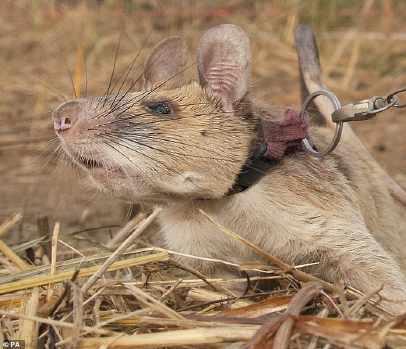
Kommentaar: Philip Malherbe
Die verwydering van die landmyne is moontlik die maklikste deel van ontmyning. Die grootse en moeilikste deel is die vind van die myne. Om ʼn mynveld skoon te maak is gewoonlik ʼn baie stadige en duur proses. Mense met metaalverklikkers, opgeleide honde of mynbestande voertuie, of persone met “prikstokke” (“prodder” in Engels) - bajonet, mes of langwerpige skerp voorwerpe kan aangewend word vir die opsporing van myne. Dit kan maklik gebeur dat ʼn klomp tyd en geld spandeer word –net om niks te vind nie. Dit is waar die Hulle is baie goedkoop om te voed, mee te broei, en te onderhou. Met hulle swak sig, maak hulle
aanwending van opgeleide rotte so voordelig is. staat op hulle op hulle goeie reuksintuig en handhaaf ʼn hoë werkslading.
Rotte leef tot 8 jaar in aanhouding, wat hulle ʼn goeie belegging maak. Met hulle lae gewig, is daar ook nie risiko’s dat hulle ʼn myn per ongeluk kan detoneer nie. Rotte het ook hul beperkings, aangesien hulle nie in digte plantegroei behoorlik kan opereer nie. Dan kan hulle ook net vir kort tye op warm dae werk, met ʼn beperkte produksie. APOPO (afkorting vir Anti-Persoonsmasjienen Otmijnende Product Ontwikkeling in Belgies) is ʼn
nie- staat organisasie asook ʼn nie-winsgewende VSA organisasie wat suidelike buidel rotte in die vroeë 1990’s begin oplei het om onder andere plofstowwe te identifiseer. Hulle noem die opgeleide rotte “Hero Rats”. Daarna is die opgeleide rotte in 2004 aangewend om landmyne en personeelmyne in Mosambiek op te spoor. In 2008 het hulle na die Gaza Strook beweeg en teen 2012 was hulle landmyn vry. In 2013 was hulle werksaam in Maputo, waarna hulle na Angola beweeg het. In 2014 het hulle Kambodja besoek.
Ander diere wat ook aangewend word vir plofstof opsporing
Honde
Die eerste aanwending van honde om bomme “uit te ruik” deur die VSA, het gedurende die Tweede Wêreld oorlog begin. In Afrika het hulle met mynopsporing honde in die laat 1980’s begin. Ekself het na my plofstopopleiding in 1980 saam met plofstofhonde geleiers begin werk. Honde se reuksintuig is maklik 50 keer sterker as die van die mens. Met die bomaanslae deur die ANC / SAKP MK kaders, wat ʼn hoogte punt gedurende die 80 jare in RSA bereik het, was vermelde honde ʼn ontsettende positiewe hulpmiddel. Destyds as ʼn bomdreigemente ontvang is vanaf ʼn winkelsentrum of staatsgebou, is vermelde geboue ontruim en moes die plofstofeenheid dit “vee” (die geboue nagaan vir verdagte pakkies). Die plofstof honde het ons taak aansienlik vergemaklik wat tydsduur aanbetref. Honde kan egter nie vir die opsporing van personeelmyne wat begrawe is aangewend word nie. Die drukkrag op ʼn personeelmyn is tussen 35 kg om te detoneer. Terroriste maak ook gebruik van personeelmyne wat hulle bo-op landmyne plaas (gemik teen persone met mynverklikkers om landmyne op te spoor). Die aktivering van ʼn personeelmyn laat dan die landmyn ook detoneer (simpatieke detonasie). Sonder die personeel myn is die drukkrag tussen 175 -200 kg om ʼn landmyn te laat detoneer. detoneer, en nie onmiddellike dood veroorsaak nie, ʼn ontsettende sielkundige effek op die res van die aanvallers, wat na die kermende swaar gewonde persone se krete moet luister – om dan te besef dat die volgende tree moontlik hul einde kan beteken. Honde werk vir liefde, om geprys te word, vir kos, maar meestal vir die pret daarvan. Dit is een groot speletjie vir hulle.
Olifante
Heel moontlik die diere met die beste reuk sintuig. Hul swaar gewig maak dit geheel en al onprakties vir myn opsporing. Hul kan wel as hulpmiddels aangewend word in lande waar hulle voorkom soos Angola, met landmyne wat nog begrawe lê. Grondmonsters wat deur hommeltuie versamel word kan deur olifante gemonitor word vir spore van plofstowwe. Dié inligting kan dan aan ontmyners in die voorste linies oorgedra word, voor ontplooiing. Die vroeë waarskuwing sisteem kan dan potensiële lewens spaar.
Varke
Varke is nog ʼn toevoeging tot die hulpmiddels om plofstowwe op te spoor. Israel is nou al ʼn jaar besig met navorsing met goeie resultate. Waar honde sukkel om diep begrawe myne op te spoor, is dit kinderspeletjies vir varke wat natuurlik kos onder die grond opspoor. Waar honde prikkelbaar is die varke meer gefokus op eet en slaap. Hulle vat ook die helfte minder tyd om opgelei te word. Die nadeel van varke is dat die hanteerder baie stil moet wees en nie hard moet praat nie en baie ontspanne moet wees. Varke geniet dit om onder die grond te vroetel en snuffel. Die probleem met varke is dat sodra hulle ʼn landmyn of plofstowwe vind, is hulle veronderstel om te sit – dit is verskriklik moeilik vir ʼn vark om te sit, aangesien dit nie ʼn natuurlike ding vir ʼn vark is nie. Varke is prooidiere teenoor honde wat roofdiere is. Jy kan maklik ʼn hond beheer deur die lyfband te trek, met ʼn vark kan jy nie dieselfde doen nie - die gevolg is dat sodra jy die lyfband styf trek, hardloop hulle weg. Jy kan net ʼn vark met kos beloon. Jy sal ook sukkel om Joodse hanteerders by varke te kry. Hulle hou van nature nie van varke nie. Selfs minder gelowige Jode het ʼn afkeer in varke.
Om honde op te lei is tydrowend, hulle moet ook gereeld oefen om skerp te wees. Dan is die opleiding koste hoog, wat kos, blyplek, dieregeneeskunde rekenings, salaris van die hondegeleiers beloop, ʼn Britse maatskappy, glo dat hulle ʼn baie goedkoper, vinniger, en net so effektiewe alternatief kan lewer: bye. Bye word opgelei deur hulle suiker water te voer terwyl hulle blootgestel word aan die reuk van plofstowwe. Daarna, wanneer die bye plofstof opspoor, self in baie klein hoeveelhede, steek hulle hul tonge (suigslurp) uit, op soek na ʼn suikeragtige happie. Opleiding duur net 10 minute, maar bly behoudend vir hul 6-weke lewensbestaan. Alhoewel dit baie korter is as die gemiddelde 10 jaar dienstydperk van plofstofhonde, is die opleiding van 500 bye per dag, daarvoor verantwoordelik vir getalle nuwe werkers. Na hul opleiding, word ʼn paar dosyn in ʼn handbeheerde apparaat geplaas, en gemonitor met infrarooi sensors, wat die verlengde tonge optel.
Met die vinnige opleiding, goedkoop kosvoorraad, en relatiewe min onderhoudkoste, kan hulle as alternatief aangewend word. Om te dink ons was van mening dat hulle net goed is om heuning te vervaardig.
Muise
In Israel, is daar ook ʼn maatskappy wat proefnemings doen met opgeleide muise om plofstowwe op te spoor, in publieke plekke soos lughawens, sport arenas, en selfs by deurry tolhekke. Ooreenstemmende handbeheerde apparate soos by bye, word aangewend en monitors word geaktiveer deur die teenwoordigheid van plofstowwe. Daar word veral toegespits op persone wat plofstowwe op hul persoon versteek. Opleiding vir een bepaalde muis duur 10 dae, en addisionele dae vir addisionele plofstowwe. Toetse het aangedui dat muise verskillende plofstowwe kan identifiseer.
Dolfyne en Seeleeus
Sedert die 1960’s, is die VSA Vloot al besig om bottelneusdolfyne en seeleeus op te lei om onderwater myne op te spoor. Dié dolfyne kan onderskei tussen plofstowwe en ander stowwe tot op ʼn afstand van 50 meter. Sodra Seeleeus met hulle uitstekende sig (5 keer sterker as die mens se sig) ʼn onderwatermyn opgespoor, stel hulle ʼn vervoerbare akoestiese merker vry wat die posisie aandui. Die dolfyne en seeleeus beweeg saam met die duikers onder water en sodra ander duikers opgemerk word, stamp hulle die duikers (saam met wie hulle opereer) se suurstoftenks en stel ʼn merker vry aan die persone bo water om behulpsaam te wees om die “vyandelike” duiker/s te arresteer. Seeleeus word ook opgelei om ʼn enkelklamp op die ongewenste duiker se enkel te plaas, in plaas van ʼn merker is daar ʼn tou aan die klamp geheg, waarvan die ander punt geheg is aan ʼn skip, rubber vlot of ander watertuig, die persone aan boord katrol dan die ongewenste persoon op na die boot, vir die “vangs” van die dag. Die program van die vloot het eers gedurende die 90 jare ongeklassifiseer geword. Sedertdien is dolfyne en seeleeus hoofsaaklik opgelei en aangewend in hawens, asook in die Persiese Golf, nadat Irak meer as 100 seemyne aldaar vrygestel het.
Plante
As dit van navorsers In die VSA afhang, sal toekomstige plofstofopspoorders nie meer neuse benodig nie. Die span aan die Colorado Universiteit het plante geneties gemoderniseer om plofstowwe en ander gevaarlike stowwe op te spoor. Sodra die hierdie plante plofstowwe naspoor, “skakel ʼn interne skakelaar aan” en verander die plante se kleur van groen na wit (wat natuurlik nie orals polities korrek aanvaar sal word nie). Sodra die plofstowwe verwyder word, keer die plante terug na hul natuurlike kleur. Die idee van die navorsers is om die plante aan te wend as vroeë waarskuwing toestelle. Dit kan dan aangewend word as opspoorders van plofstowwe, skadelike chemikalieë en biologiese wapens, self omgewings besoedelaars. Die idee is om verkillende plante aan te wend om
verskillende bedreigings te identifiseer. As voorbeeld, indien sekere plante met byvoorbeeld wit blomme aan die buitekant van ʼn lughawe voorkom, sal hulle ook rooi rose plant, wat nie van kleur verander nie. Indien die rose wel verkleur, dui dit daarop dat plofstof in die omgewing is, maar byvoorbeeld, nie verdowingmiddels nie. Bome sal ook dan aangewend kan word wat die voordeel het die blare vanuit die lug deur vliegtuie, hommeltuie of satelliete gemonitor kan word. Tans neem die kleur verandering taamlik tyd in beslag, en daar word onverpoosd gewerk om die verkleuring na enkele minute in die toekoms te versnel.
Sprinkane:
In Washington Universiteit in die VSA, kon wetenskaplikes daarin slaag om sprinkane se brein binne te dring en hul reukvermoë uit te sorteer, met die oogmerk om die insekte aan te wend om plofstowwe op te spoor. Waar die mens se reukvermoë by sy neus begin, maak sprinkane gebruik van chemiese energie wat vervat is in hul voelhoring of tasorgaan om reuke te onderskei. Elke antenna of tasorgaan bevat 50,000 neurone of senuselle, sodra hulle ʼn reuk ervaar, word ʼn elektriese sein na ʼn gedeelte van die brein gestuur, dit word die “antenna lob” genoem. Die wetenskaplikes het elektrone in die antenna lobbe ingeplant. Hulle stel dan die insek bloot aan verskillende reuke – insluitende plofstowwe.
sniffing dogs with AR goggles the dog without being in harms way
• Indicators appear for dogs to follow and sol-
diers can see what it sees
By Stacy Liberatore for dailymail.com Published: 22:46BST, 7 October 2020 | Updated: 15:46 BST, 9 October 2020 Daarna het hulle verder gegaan en ʼn miniatuur rugsak vervaardig, wat hulle aan die sprinkane geheg het, elke rugsak bevat ʼn sensor wat die data van die insek se brein se elektrodes na ʼn rekenaar stuur. Deur die elektriese seine te analiseer, kon hulle vasstel wanneer die sprinkaan verskillende plofstowwe ruik. Alhoewel die rugsak baie lig is, was dit swaar genoeg om die sprinkaan bewegingloos te maak, dus word die sprinkane op ʼn afstand beheerde platform arm geplaas. Die platform is dan na verskillende plekke beweeg. Deur die individuele sprinkane se breinaktiwiteite te analiseer, kon hulle 60% van plekke identifiseer waar die grootste konsentrasie plofstowwe aanwesig was. Sodra sewe sprinkane saam gewerk het die slaagsyfer na 80% gestyg. Nadele wat op hierdie stadium geïdentifiseer is, is die feit dat na die koppeling van die elektrodes aan die brein, ʼn venster tydperk van 7 ure van opsporing toelaat, voordat die insekte aan uitputting begin ly en doodgaan.
Bronne
https://www.globalcitizen.org/ https://homeofvaporwake.com/
https://www.dhs.gov/publication/ https;//theconversation.com/ https://www.mentalflooss.com/ http://vanplofstowwe www.nolandmines.com/
US Army is developing AR goggles for Dogs that displays directions to help them search areas for explosives, allowing soldiers to keep a safe distance form war zones
• The US Army is working to provide its bomb
• This allows handlers to provide directions to
https:www.freethink.com/ Dogs have been helping soldiers on the battlefield for decades and now they are about to receive an upgrade. The US Army is giving its canine force augmented reality goggles that allows the handler to give specific directional commands while keeping a safe distance from the war zone. The device has been customized to fit each dog, which displays indicators for them to follow - and
the handler can see everything in the animal's view. The Seattle-based firm called Command Sight has designed a wired prototype, but is set to build a wireless version in the next phase of development.
The US Army is giving its canine force augmented reality goggles that allow the handler to give specific directional commands while keeping a safe distance from the war zone
Dr. Stephen Lee, senior scientist at the US Army Research Office, said: 'Augmented reality works differently for dogs than for humans.' 'AR will be used to provide dogs with commands

and cues; it's not for the dog to interact with it like a human does. This new technology offers us a critical tool to better communicate with military working dogs.' Command Sight is working with the Army in developing the googles, which are currently in the prototype stage. The device is currently wired, while a dog is on a leash, but the next phase will see a wireless version.
The device has been customized to fit each dog that displays indicators in for them to follow and the handler can see everything in the animal's view
Dr. A.J. Peper, Command Sight founder, said: 'We are still in the beginning research stages of applying this technology to dogs, but the results from our initial research are extremely promising.'
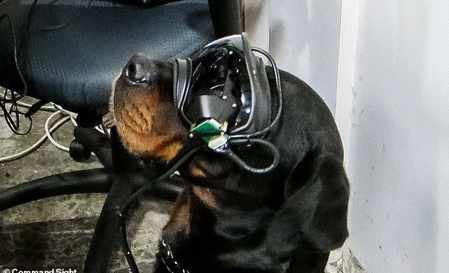
The team has been conducting tests with Peper's Rottweiler, Matter. 'His ability to generalize from other training to working through the AR goggles has been incredible,' explained Peper. 'We still have a way to go from a basic science and development perspective before it will be ready for the wear and tear our military dogs will place on the units.' Special Force dogs typically relay on the hand signals of a human soldier, meaning they both must stay near each other. The issue is, these animals are tasked with sniffing out bombs and hazardous material on the battlefield, which can be a dangerous place for humans. However, the googles aim to offer an alternative. 'The military working dog community is very excited about the potential of this technology,' Lee said. 'This technology really cuts new ground and opens up possibilities that we haven't considered yet.'
The US military began using canines in the battlefield during World War I, but the canines were not officially recognized until 1942. There are about 25,000 dogs currently in active service and more than 700 are deployed overseas
The augmented reality system uses goggles military working dogs have already been wearing for protection in inclement conditions and aerial de-

ployments from Rex Specs. By leveraging a product dogs are comfortable wearing, Peper said it makes the technology adoption easier for both the dogs and the handler. The Department of Defense Rapid Reaction Technology Office has provided funding for the next phase of development. With that funding, Command Sight is now working with Navy Special Forces to build prototypes that will be tested on their military working dogs. Each of the dogs received a 3D scan to get dimensional data to understand where to place optics and electrical components, specific to each dog.
(Continued from page 85)
Share or comment on this article:
The US military began using canines in the battle- US Army is developing AR goggles for DOGS field during World War I, but the canines were not that displays directions to guide them in the officially recognized until 1942. field There are about 25,000 dogs currently in active https://www.dailymail.co.uk/ service and more than 700 are deployed overseas.
Kommentaar deur lt.kol. P Malherbe augmented reality goggles for military dogs. The Baie interessant, as ek die artikel reg verstaan is technology is being designed to enhance die doel van die navorsing om honde se visie en communication between the dog and its human waarneming te verstaan, om kommunikasie te handler, allowing for more remote commanding of verbeter tussen die hanteerder en die hond, wat the animal”. sal lei tot afstand beheer oor die hond. https://www.fox5ny.com/news/army-testing“The United States Army is developing augmented-reality-goggles-for-dogs

Onder redaksie van Frans Bedford-Visser


Suidwes Staaltjies en Verhale
Die “Koekblik” en die “Koeikamp”
Nie net was daar ʼn groot gebrek aan akkommodasie in Windhoek nie, maar ook ʼn groot tekort aan dames geselskap. Die grootste werkgewers, ook vir dames werknemers, was die S.A. Spoorweë en die S.W.A. Administrasie en daarom was die oprigting van enkelkwartiere vir dié werknemers ʼn noodsaaklikheid. Die twee enkelkwartiere van die dames het derhalwe, gebore uit mans se ondeunde aard, elkeen ʼn naam gekry. Die enkelkwartiere waar die dames gebly het wat in die Spoorweë gewerk het, was die “Koekblik” gedoop, terwyl die kwartiere waar die dames van die Administrasie in gewoon het, die “Koeikamp” genoem was. Soos gebruiklik op ‘n Saterdagaand, was die jong manne van die S.A. Polisie en S.A. Spoorwegpolisie dringend op soek na dames geselskap. Ons het na die “Koeikamp” gestap wat ongeveer 4 kilometer vanaf die kantore van die SAP kantoor, regoor die Windhoek hospitaal, geleë was. Ons moes
Majoor Ronnie Beyl te Slagboom-opleidingsentrum—altyd die grapmaker! (Foto Ronnie Beyl versameling) noodgedwonge stap want ons was nie so bevoorreg om ʼn motor te kon besit nie; inteendeel, ons het nie eers geld gehad nie. Dit was ongeveer agt uur op die betrokke Saterdagaand en ons was so agt manne bymekaar. Ons het die deurklokkie gedruk by die Koeikamp en na ongeveer drie minute het ʼn oorgewig dame die deur oopgemaak en gesê haar naam is Lulu. Soos ʼn koor het ons aangekondig dat ons op soek was na “girls” vir die aand. Lulu het ons ingelig dat ons nie daardie tyd van die aand enige “girls” sou kry nie. Japie Jacobs, wat vir die eerste span senter gespeel het, het toe vir Lulu gesê: “Maar hulle sê as ons “girls” soek moet ons Koeikamp toe kom.” Wat ʼn flater! “Luister”, het Lulu geantwoord: “By ʼn koeikamp sal julle nie “girls” kry nie”, en daarmee het sy die deur in ons gesigte toegeslaan. Nodeloos om te sê dat Japie dit van almal gekry het. Al die moeite was vir niks. Ons was nooit by die Koekblik aan nie. Wat kon ons anders doen as om droëbek vir onsself by die polisiestasie te gaan sit en lag?

(Tjaka Neethling)
Moenie na my kyk nie, jy maak my skaam.
Tug en dissipline was ʼn ernstige saak in Suidwes-Afrika. Jy kon letterlik nie ‘n oog knip nie of jy was afbetaal. Maar om stout te wees is en was darem ook lekker. Ek was ʼn Prefek, nie net vir die S.A. Spoorwegpolisie nie, maar ook in die Philip Troskie–tehuis waar ons tuisgegaan het. Ek was ʼn baie netjiese prefek. Die vloer van my kamer, asook die stoep, was rooi gepolitoer en het geblink soos ‘n spieël. Dit was ʼn Sondagaand, so omstreeks agt uur se kant toe konstabel Bill Marais my kamer binnegekom het terwyl ek reeds
in die bed was. Hy het voorgestel dat ons vir Jaap Louw ʼn poets moes bak. Ek verneem toe wat se poets ons hom kon bak? Bill het gesê dat ons in Jaap se broek moes ‘dinges’. Hy het verduidelik dat Jaap al geslaap het, maar ek wou weet hoe dit moontlik was om in ʼn ander man, wat geslaap het, se broek te ‘dinges’? Hy het verduidelik dat ek moes ’dinges’ waarna ons die opbrengs in Jaap se broek moes sit. Ek het voorgestel dat Bill eerder moes ‘dinges’, maar hy het geantwoord dat hy nie op daardie oomblik ʼn behoefte gehad het nie. Ek het toe aan hom gesê dat ek ook nie op daardie tydstip ʼn behoefte gehad het om te ’dinges’ nie. Maar hoe meer ek oor die moontlikhede gedink het, hoe meer opwindend het dit vir my gelyk. Bill het my mettertyd oorreed om te probeer ’dinges’ en ek het toe opgestaan en ʼn stukkende rugbykous agter die hangkas uitgehaal waar talle geskeurde truie en stukkende kouse gelê het. Ek het die kous op my rooi gepoleerde vloer uitgegooi en ʼn gehurkte posisie bo-oor die kous ingeneem en begin druk. Met die gedruk het dit begin voel ek dat ek ook wou ‘pxs’. Ek het vir Bill gesê dat ek nie op my vloer gaan ‘pxs’ nie en hy het besluit om iets te gaan haal waarin ek kon ‘pxs’; ʼn leë visblikkie moes
Tjaka Neethling (links), outeur van die maand se verhale uit Ronnie Beyl se boek, saam met Hannes Slabbert (middel) en Wietsche Fourie (regs) by ‘n oud –spoorwegpolisie byeenkoms. (Foto deur Wietsche Fourie)

toe die ding doen. Hy het plat op sy maag gaan lê op die rooi gepoleerde vloer en die blikkie voor my gehou. “Bill,” het ek ernstig gesê, “maak seker dat ek nie op my rooi vloer nat maak nie!” Ek het bygevoeg, dat hy nie na my moes kyk nie,
Ek het gedruk vir al wat ek werd was en na ongeveer drie minute het daar ʼn redelike stywe opbrengs op die sokkie geval; nogal met ʼn klankie daarby. Dit was amper nie nodig nie, maar ek het my met die sokkie afgeveeg en die opbrengs mooi daarin opgerol. Daarna was ons op pad na Jaap Louw se kamer toe met die kous. Ons het die deur versigtig oopgemaak en die lig aangeskakel, maar Jaap Louw het soos ʼn bees geslaap. Hy was kaal bolyf en het net ʼn PT broekie aangehad. Bill Marais het die rek van sy broek weggetrek en ek het die sokkie met die opbrengs daarin vorentoe en agtertoe beweeg om dit perfek te laat val waar dit moes wees. Ek het die opbrengs ingeskiet en, soos die geluk dit wou hê, het dit net mooi netjies op Jaap Louw se kruis beland. Bill het die broek se rek stadig laat los tot terug na sy middellyf terwyl Jaap Louw ongestoord voort gesnork het. Die klank het hom nie eens wakker gemaak nie. Ons het die kamer verlaat, die lig afgeskakel en die hele oefening bespreek toe ons terug was in my kamer. Die volgende dag het Jaap Louw, so omstreeks half elf, by my kamer aangekom en doodluiters verneem na my welstand asook my bewegings van die aand tevore. Ek het ewe onskuldig vir hom laat verstaan dat ek maar daar rond was en dat ek vroeg gaan slaap het. “Hoekom vra jy?”, wou ek weet. “Nee”, het hy geantwoord, “ek vra maar net.” Intussen het Bill Marais die hele gebeurtenis van die vorige aand aan die manne by die aanklagtekantoor gaan oorvertel. Ek het besef dat ek my werk kon verloor as gevolg van Bill Marais se losbekkigheid. Jaap Louw was die klaer by die ondersoek en die klag was: “Daar is in sy broek gek#k.” Jaap se weergawe van die gebeurtenis het soos volg verloop. “Sersant ek het gisteraand vroeg gaan slaap. Ek was kaal bolyf met net ʼn PT broekie aan. Dit was ongeveer drie uur in die oggend toe ek my omdraai. Sersant weet moes as ʼn mens jou in jou slaap omdraai, dan is jy so tussen slaap en wakker. Toe ek omdraai, toe ruik ek daar is ʼn klank onder die kombers. Nou is ek heeltemal wakker. Die kamers het nie ʼn bedskakelaar nie en dit is donker. Sersant, wat maak ʼn man nou as jy k#k ruik, maar jy kan dit nie sien nie? Daardie tyd toe steek ek my hand agter my broek in om te voel of ek nie miskien in my broek gek#k het nie. Toe ek my hand instamp, toe voel ek maar hier is iets. Sersant, jy voel iets maar jy kan dit nie sien nie en daardie tyd toe stamp ek my hand voor my neus vas. Ek besef toe hierdie is definitief k#k. Ek spring uit die bed en skakel die lig by die deur aan. Ek trek my broek uit en sien ʼn half verminkte drxl daarin. My hand is vol k#k, my neus is vol k#k en my kruis is vol k#k. Sersant ek kon nie verstaan hoe ek op my kruis kon k#k nie. Ek gaan sit op die matjie voor my bed. Ek voel aan my agterstewe, maar dit is heeltemal droog. Toe besef ek dat ek nie in my broek gek#k het nie en dat dié k#k nie my k#k is nie. Ek wil nie ʼn klagte maak nie omdat dit my slegs sal verneder, maar wil graag hê dat die betrokkenes voor ʼn offisier moet verskyn.”
Ek was opdrag gegee om by sersant Oberholzer, die persoonlike klerk van die bevelvoerende offisier, aan te meld. Ek het geweet dit was oordeelsdag toe sersant Oberholzer my paradeer en die deur oopmaak. Die bevel het gekom: “Voorwaarts mars, halt, salueer en op die plek rus.” Kaptein van Niekerk het so oor sy bril na my gekyk en gevra: “Wat maak jy hier?” Ek het gesê: “Ek weet nie kaptein; hulle sê ek het in Jaap Louw se broek gek#k. Maar, kaptein, hoe kan een man nou in ʼn ander man se broek k#k?” Kaptein van Niekerk se bevinding en uitspraak het hard en duidelik gekom: “Jou bliksem, jy het te veel energie. F@&#off en laat jy nou weer voor my verskyn vir ʼn broek k#kkery.” Die bevel het gekom “Aandag, salueer, omkeer, voorwaarts mars.“ Nadat ek uit was, was sersant Oberholzer terug na die bevelvoerende offisier se kantoor en hy het die kaptein gevind met sy kop op die tafel terwyl hy geskater het van die lag. Sersant Oberholzer, hy was toevallig my oom, het soos volg gerapporteer: “Dis ʼn stout mannetjie hierdie, maar hy is ʼn goeie polisieman”, was die opmerking van die bevelvoerende Offisier. (Tjaka Neethling)
DIE SPESIALE TAAKMAG

deur Ronnie Beyl
As gevolg van die politieke klimaat wat in 1974 in die land geheers het, het die destydse Buitendag, opdrag gegee om die moontlikheid te ondersoek om 'n taakmag op die been te bring wat vir gespesialiseerde take aangewend kon word. Die onrus in die land het toegeneem en op daardie stadium was daar nie in Suid- Afrika ʼn taakspan wat vir sodanige operasies opgelei was nie. Op 7 Maart 1975 het brig. Buitendag ʼn konsepvoorstel aan generaal Van Vuuren voorgelê waarin hy aanbeveel het dat ʼn groep kommissaris, generaal-majoor J.J.J. van Vuuren, bestaande uit twee gevegsgroepe (sestig man), by die militêre opleidingsterrein van die S.A. Weermag op Oudtshoorn opgelei moes word. Luitenant Phillip Delport van die kollege, luit. Grant-Grierson, wat spesiaal vir die opleiding van buite die Mag in diens geneem was, AO Ronnie Beyl, posbevelvoerder te Komatipoort, sersant Johan Lotriet en konstabel Riaan Stander, beide instrukteurs verbonde aan die kollege te Esselenpark, was die stigterslede en het as instrukteurs opgetree. Luitenant Delport, AO Beyl
S.A. Spoorwegpolisie Spesiale Taakmag op Slagboom. 16 Mei 1982 Vertoning aan Min Schoeman (Foto Hein Crocker)

aan die assistent-kommissaris, brigadier J.P. en sersant Lotriet het die Staandemag Deel 1 Instrukteurskursus, wat by die Infanterieskool te Oudtshoorn aangebied was, deurloop alvorens hulle as instrukteurs by die kollege aangestel was. Konstabel Stander was voorheen aan die S.A. Polisie verbonde en het dienste in die eertydse Rhodesië gedoen. Genoemde instrukteurs was getaak om die inhoud van die handleidings en kursusprogram
saam te stel wat oor ʼn tydperk van drie maande gestrek het. Die bevelsgroep vir die twee gevegspanne was geïdentifiseer en het 'n twee weke oriënteringskursus by die kollege deurloop voordat hulle na Oudtshoorn vir die opleiding vertrek het. Die volgende lede het die bevelsgroep uitgemaak. Majoor Daantjie Malan as die bevelvoerder, kaptein Naba Kemp, luitenant Tjaka Neethling, luitenant Dennis Keyter. luitenant Loeba Roelofse, AO’s
Johan Piek, Gert Louw, Herman Buckingham en Charl du Toit. Die SAW het die opleidingsterrein bekend as “Kansasvlakte”, wat op die pad tussen Oudtshoorn en Calitzdorp geleë is, aan die S.A. Spoorwegpolisie vir die opleiding beskikbaar gestel. Daar was slegs 'n sinkgeboutjie wat as 'n pakkamer aangewend was en 'n sink afskorting met koue water vir storte. Verder was dit kaal vlaktes met geen bome nie en met net die pragtigste lappe vygies wat in die blomseisoen oopgegaan het. Die offisiere en die lede het in weermagtente tuisgegaan. Teoretiese lesings was in tente aangebied terwyl die etes vanaf die menasie in die hoofbasis in warm houers na die basis gestuur was. Teen die tyd dat die etes by die basis arriveer het, was dit yskoud en onsmaaklik. Gedurende die opleidingsperiode het ons die uiterstes van die weer en klimaat ervaar. Gedurende die winter was dit ook die reënseisoen in Oudtshoorn. Soggens vyf uur, wanneer ons opgestaan het, was die dak van die tent gevries en dan het dit soos die hemelruim met sy sterretjies gelyk. Om saans te gaan stort was 'n oorlewingsoefening op sy eie met die koue temperature en koue water. In die somer was die tent weer soos ʼn bakoond en moes ons doodeenvoudig lafenis buite die tent gaan soek het. So het ons in die koelte van die tent rondom die tent beweeg. Die eerste groep se opleiding het gestrek vanaf 7 Julie tot 20 September 1975.

Die instrukteurs was toegelaat om hul families te gaan besoek vanaf 21 September tot die 29ste September. Die tweede groep se opleiding het op 30 September begin en geduur tot 11 Desember 1975. Die opleidingskursus het hoofsaaklik op plattelandse sowel as stedelike operasies gefokus, selfverdediging, absailing, gevorderde skietkuns, vasbyt oefeninge, ens. Die vuurdoopbaan was sekerlik vir die manne die ergste. Dit was waar daar met 'n ligte masjien geweer sarsies met lewendige ammunisie bo-oor hulle koppe geskiet was. Die absailing het ons by die treinbrug buite Oudtshoorn gedoen. Dit was vir almal van die manne ʼn eerste ervaring. Die roete en nagmars in die Swartberge en die vasbyt oefeninge het die seuns van die manne geskei. Ons was dankbaar dat tydens die opleiding daar geen ongevalle was nie. Na afloop van die tweede kursus in Desember 1975, was lede van die Spesiale Taakmag by die Oshivelo hek by Ovamboland ontplooi waar hulle alle busse en voertuie wat deur die grenspos gegaan het, deursoek het. Die sterkte van die ontplooide lede was mettertyd verhoog en 'n aantal lede het treine wat S.A. Weermag lede na en van die grens vervoer het, begelei, asook brandstof- en ander goederetreine. Die lede wat nie in die Noorde van Suidwes-Afrika diens gedoen het nie, was op al die groot sentra in die land op Spoorwegstasies en Lughawens ontplooi. Talle van die taakmag lede was gedurende die 1976 onluste in Soweto ontplooi vir die beskerming van die Spoorweë se personeel, eiendom en die passasiers.
Hulle het ook talle BBP’s deur die gebied begelei.
1975—1986
Maj. DF Malan: 07/03/1975 - 24/06/1980 Kol. AF Horak: 26/06/1980 - 30/03/1983 Kapt. AE Olivier: 01/04/1983 - 30/06/1984 Kapt. JF Lotriet: 01/07/1984 - 31/07/1986 Kapt. EF Boucher: 01/08/1986 - 01/10/1986
Brig. D.F. Malan

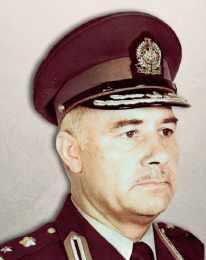
Genl A.F. Horak
Kol. A.E. Olivier



Kapt. J.F. Lotriet

Taakmag Vlerke—1ste Weergawe


by Hein Crocker
Where does one start when you want to account for your upbringing, career choices and your current status? I was born on the 15th August 1961 as one of triplets, a rare occurrence and I believe the first triplets to be born in the Western Cape. I was one of 12 children and my Mom and Dad got divorced when I was 7 years old. My Mom, who never remarried, took care of all of us and I recall that even though we were poor my mom always managed to put food on the table. Up to today I am still not sure how she managed to do that. Needless to say that in those years when you have passed standard eight you had to go out and work. I left school in March 1978 after the first quarter in standard 9 at the age of 16 and decided to join the South African Railways Police. I will never forget when arriving at the employment office finding Sergeant Du Plooy in a room full of young men wanting to join the South African Railways Police. There was no open chair to sit down and one of the boys suggested that I sit on one of the tables. Sergeant Du Plooy was not impressed and I was told to leave the office and after some profuse apologies was allowed to complete the necessary application forms. Two weeks later I was told to report at the Belleville Railways Police Station. I was a recruit constable with a yellow band around the cap. The only weapon of defence was a baton. You always had to work with a constable and were taught to listen up and learn the trade. I was only eligible to go to the Police Training College when I turned 18 and found myself being a recruit constable for 15 Months. I was fortunate to work at various locations to learn the trade, including Cape Town Station, D.F. Malan Airport and ended up at Cape Town Harbour. I reported for training at Esselen Park College on the 9th July 1979 and was in Platoon 143. Our Platoon Sergeant was Sergeant P.G. Heyns. Our Platoon had some outstanding recruits and we were the winners of the Tug Of War, Athletics, Cross Country, Command Shield and we shared the Drill Trophy with Platoon 142. When I left the College I was told to report for duty at Jan Smuts Airport. On the 12 May 1980 I received a letter
Hein and his wife Marlene during a recent family trip

from the Commissioner of the South African Railways Police informing me that I have been appointment to permanent employment as a Constable. I was eager to study and already managed to pass my Sergeant exams in April of 1980 before I was permanently appointed as a Constable. You were only allowed to be promoted to the rank of Sergeant when you turn 20 and I became one of the youngest acting Sergeants at the age of 18. In 1981 I was promoted to Full Sergeant. In 1980 the S.A. Railways Police started their own Special Task Force and I went to the very first selection course and under gruelling conditions and supervision of then Captain Andre Olivier and Lieutenant Flip Schutte managed to past selection and became a member of the Special Task Force. Initially we attended training on an ad-hoc basis until the unit became permanent in 1984. I was also very fortunate to become a Sky Marshall on South African Airways and had the privilege to travel the world. I continued my studies and in June 1983 I passed the National Higher Certificate in Police Science
and on 1 January 1984, at the age of 23 became a Warrant Officer.
The Special Task Force was then under the command of then Captain J.F. Lotriet and we were able to attend a number of specialised courses. Most notably were courses done at 1 Reconnaissance Regiment in Durban. This included Urban Operations and Basic and Advanced Demolition courses. We were trained by the best and excelled as members of the South African Railways Police Special Task force. We also did a number of other courses including Hostage Negotiations, VIP Protection, Advanced Special Task force and an Explosives Course where I was the best student with a passing percentage of 99,28%. In 1985 I was appointed as one of two Unit commanders at the S.A. Railways Police Special Task Force. I began studying towards my National Diploma in Police Science and was informed that I could not be promoted to an officer without a Matric Qualification. I obtained a “Regsmatriek”
The author with a colleague at Slagboom, the SARP special training centre in the Eastern Cape, near Addo. through the Department of Higher Education which was regarded as being equal to a school matric. In December of 1986 at the age of 25 I obtained my National Diploma in Police Science. It was also the year that the amalgamation between the South African Police and the South African Railways Police took place. In April of 1987 we were the first group of Warrant Officers from the old S.A. Railways Police who attended a Candidate Officers course in the S.A. Police.


I was appointed as a Lieutenant on the 1 July 1987. I was transferred back to the S.A.R.P Special Task force which was still
operating apart from the South African Police Special Task Force. We were stationed at Jan Smuts Airport. When our unit was closed down I became a Shift Commander at the S.A. Police Station at Jan Smuts Airport.

On the 15th of November 1989 I resigned from the S.A. Police and because of the void that was left after the amalgamation Spoornet was in dire need of security and I immediately thereafter joined Spoornet Security as a Training Manager at the Esselen Park Spoornet Security Training College. In 1990 I headed up a Crime Prevention Unit and returned to the training college in 1993 before resigning in 1994. I then spent what I regarded as the most wonderful 6 years of my life as a Farm Manager in the Hex River Valley in the Western Cape, farming with export table grapes. I was also a member of the farmers’ association and played an active role in training farm managers after developing two training courses in Pack Store Management and Vineyard Management. On two occasions I was also privileged to be recognised amongst the five best farm managers at annual vineyard competitions held in the Hexriver Valley. With no agricultural background or a tertiary qualification in farming I firmly believed that if you are able to manage people and resources, you can manage in any work environment. In 1999 we moved to Durban where I was appointed as General Manager for a security company and in 2001 I started a business called Dreamworks Technologies which specialised in Fuel Management with the emphasis on fuel fraud/theft detection and as the Managing Director built the Company up and became a major role player in the fuel management industry. In 2011 we sold the business to a leading fleet management company where I stayed on as Head of the Division until December 2015. Our family then moved to the town of Oudtshoorn in the Western Cape. My wife became a partner in a Restaurant in town and I started a long life passion of community work where I presented skills training to the underprivileged communities and was also the Chairman of Afriforum in Oudtshoorn. In 2017 I also started a Company, SQAS-SA where we provide services nationally to the Transport industry and specialises in Fuel Management and assisting companies to obtain accreditation to enable them to transport classified Dangerous Goods. I attribute my successes I have achieved to my wonderful wife Marlene, who support me through thick and thin and the upbringing I had from a
single Mom of 12 and the dedication and determination she showed with her “never give up” attitude.

As regards Nongqai, having been involved in the development of the S.A. Railways Police Special Task Force website and Facebook group, in which their history is documented, I am keen that the history of our Force be preserved for posterity, and I believe that Nongqai offers an excellent channel for doing this. I would like to take the opportunity to thank the editor and contributors of Nongqai for the sterling job they do, not only for the Railways Above: Hein Crocker, third from left, as a member of Spoornet’s Security detail. Police, but for all legacy South African security forces. Below: Hein Crocker in his position as a Farm Manager in the Hex River Valley in the Western Cape, farming with export table grapes.
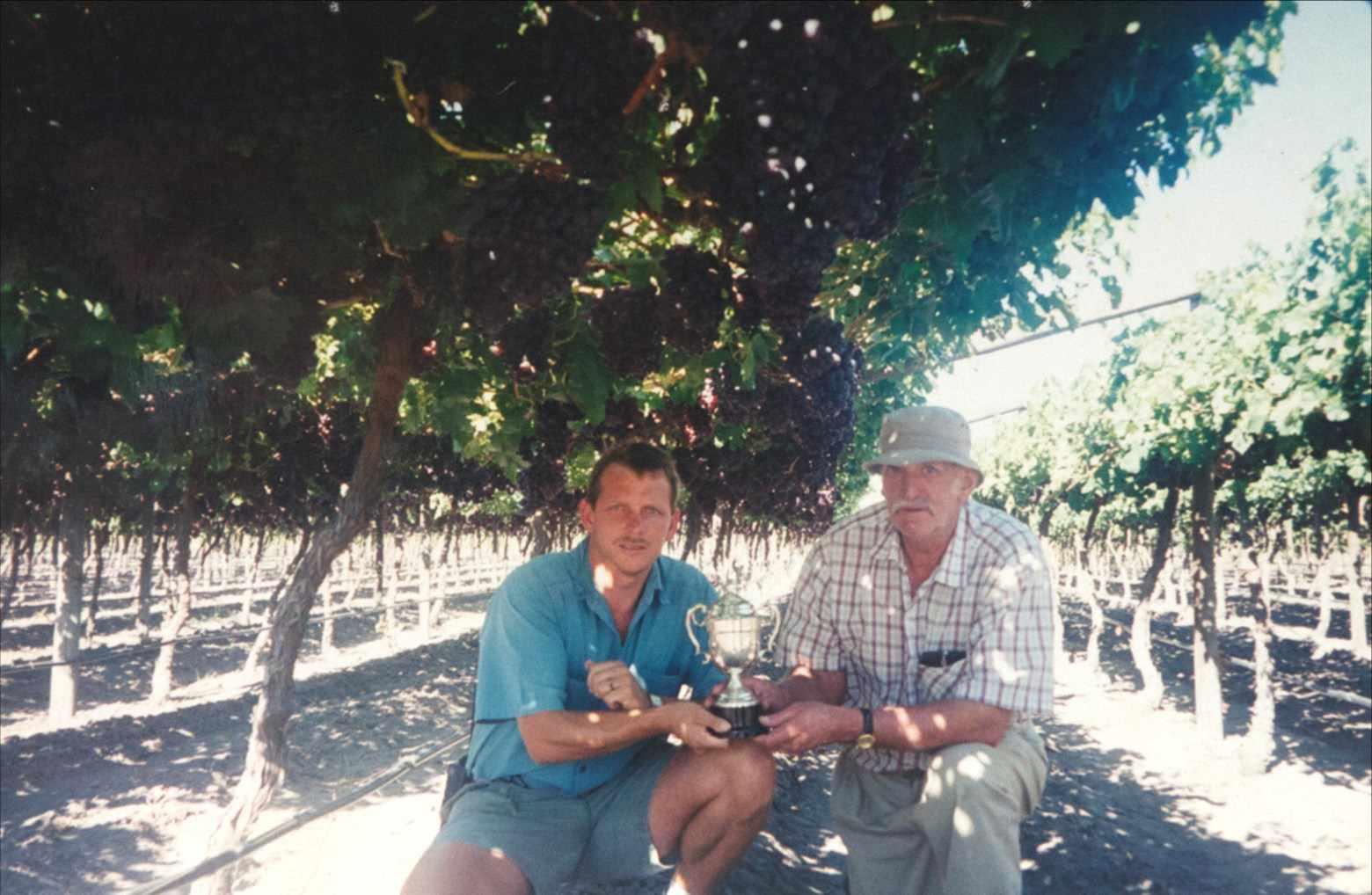
REMINISCENCES OF A towards this man walking like a did still soaking wet. RAILWAYS POLICEMAN duck. Now my mind worked overtime, by Keith Blake I stopped next to him and me and my colleagues in the back of he had shown this woman foreign notes but we found the van surrounded him. The nothing on him absolutely first thing I noticed why the duck nothing and now my interest was walk; he was soaking wet. I reaching boiling point. asked him for an explanation for There was two songs that made his wetness and he told me he the top chart the one was those works for Irvin and Johnson and boots were made for walking while offloading a ship he fell in- and those blue suede shoes but to the water. I asked him where in this song the takkies would the ship was and he told me at C lead to iron bars. berth and I then knew he was lying because Irvin and Johnson ships were at West and South Arm Quay and C berth was used by the Fruit Board. I again just to get my fact right asked Patat if he went onto this ship we are standing by and he told me that he did not. I then took his takkies, handcuffed him Keith Blake I then searched him all over and and went with permission onto he had nothing absolutely the ship. Faster than Scotland Yard - Suspect walked like a Duck. (Part 1) The following story occurred when I was a member of the S.A. Railways Police in the late 1980's. We were working the old night shift timeframe 22:00 till 06:00 and I had posted all my members on their different beats. I then at about 03:00 decided to post members at all the harbour entrances to arrest prostitutes trying to get to the ships. All went well and numerous arrests were made and at about 05:00 I decided to drive the patrol van and pick up all the members at the different gates which I did. nothing on him. We placed him in the van and I drove to C berth and here was this huge ship. I then asked the suspect who told me his nickname was Patat to show me where he fell into the sea. We went to the front of the ship by the thick berthing rope and there on the quayside was distinct shoe prints. I asked the suspect to take off his takkies and the prints on the quay was the same. I then asked Patat if he was on the ship which he vehemently denied and I still remember his words: "Nee meneer ek was nie op die skip nie. Wat moet ek op die skip doen?" I looked up and saw the rope lead to the ships top deck. I then went to the gangplank and a Filipino crew member was on guard My colleagues and I climbed right till the top deck and lo and behold there in the moist metal deck was footprints and they matched Patat's takkies foot print perfectly and to my surprise the takkies footprints lead to a door that lead to the ship's officers cabins. By this time Patat had taken a vow of silence and he was sweating in the cold morning sea air. I went into the passage tried the first door, no it was locked, went to the Chief Engineer's cabin and yes it was not locked. I opened the door and switched on the light and this son of England awoke quite alarmed but I reassured him we were members of the S.A. Railway Police busy with an investigation. I asked him if there was any money missing or any valuables. I then drove into South Arm duty but his girlfriend standing He said there was nothing as his Road towards the traffic circle next to me indicated she want to wallet was in his bed side cupand I saw this big built man talk to me. I went onto the ship board drawer. I asked him to walking like a duck near a shop and she told me but Patat was open the drawer, which he did called Jetta’s Café. I drove past earlier by the gangplank and and said the following. him but watched him in the mirror and as I passed, he stopped walking and looked at the van. I stopped and then he walked again. I decided to investigate and went around the circle and drove back asked for a towel and he told her that he was wet and that his money was also wet and he showed her wet foreign notes. But her boyfriend told her that the suspect cannot get a towel and that he must go which he “Thank goodness me wallet is safe in me drawer!" I then then to him to open the wallet which he did. There was a look of shock on his face and said the following, (Continued on page 98)
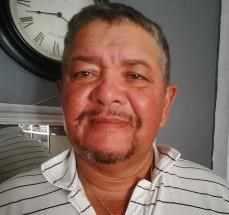
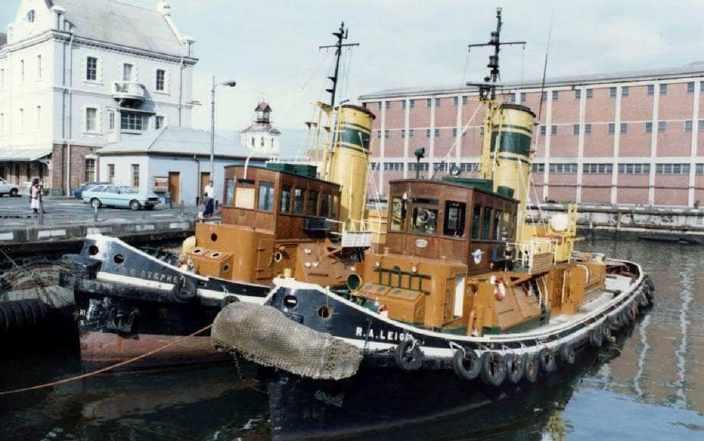
“Oh me goodness me, money is all gone.“ I asked him what in what kind of currencies were his money and he responded it was pound, dollars and Mauritian rupees. The time was about 06h00. I asked the complainant when their ship was sailing and he responded that same day at 16h00. I told him that we were going to leave but I will be back. must come and see what he has found. SOUTH AFRICA IS FASTER THAN SCOTLAND YARD.' We left the ship and searched the route we suspected Patat would have taken, searched everywhere but no money. We came to the shop where I had first found Patat and posted a guard there and told him nobody not even the shop owner was Behind the shop was a wall from an adjacent yard of the S.A. Railways garage and attached to this wall was the long pipe and behind this pipe was a large wet bundle of dollars, pounds and Mauritian rupees. HET JOU AKKEDIS! A few days later I gave evidence not knowing a reporter of the Cape Times was in the court looking for a story and the next morning the headlines read “MAN WALKING LIKE A DUCK SENTENCED TO THREE YEARS” allowed near the shop and the We drove to the ship and When Patat came out of jail he area around the shop until came handed the Engineer his stolen was twice arrested by us in the back. money. The detectives took his harbour for robberies on board It was still dark and my colleagues went off duty but I stayed on and waited till the detectives came on duty. I arranged for a relief for my colleague guarding the shop area with the morning shift commander. statement and mine and, in those years, arranged for a "kitsverhoor" so that the Engineer can give evidence before the ship sailed. I went home and fell into a deep sleep. Later that afternoon I received a call from one of the detectives ships. The first time he jumped out his window in Parkwood into or waiting colleagues’ arms, the second time we found him hiding in his cupboard and in that case the one detective found the stolen jacket also in the cupboard. Patat was watching me but said and he said he was in court and nothing and I had his takkies in the Engineer gave his evidence my possession. I was very deter- but the followings words made mined to solve this case even us proud he told the court and I though I was tired. quote what I was told. That morning detectives Frans “YOUR WORSHIP I WAS and Koos Etzebeth and I think ASLEEP IN MY CABIN AND there were others when I told WAS AWAKEN BY THE RAILthem the story we all went to the WAY POLICE AND I DISCOVJetta’s Café where I had found ERED ME MONEY WAS GONE Patat and we started to do a BUT IN A FEW HOURS ME slow search, when all of a MONEY WAS GIVEN BACK TO sudden Frans shouted that we ME I MUST SAY YOUR WORSHIP THE POLICE HERE IN

DIE SPEURDER
deur Johan de Jager
HOOFSTUK 18
SPESIALE TAAKMAG OPLEIDING Al die lede van die Mag wat die keuringsproses suksesvol voltooi het, begin die intensiewe opleidings program by Kansasvlakte wat net buite Oudtshoorn op pad na Calitzdorp geleë is. Die tydperk strek vanaf 1 Julie 1975 en eindig op 20 September 1975. Dit was yskoud saans en vrek warm in die dag! Baie vroeg uit die vere, vyf uur elke oggend. Die dakke van die tente waarin ons geslaap het, was regtig gevries en het ook behoorlik geskitter soos die sterrehemel! Dit was ook nie nodig om gedurende die aand op te staan om te gaan ‘piepie’ nie, jy het dit sommer in die bed gedoen en die volgende oggend net die ysblokkies uitgeskud! (ha-ha) Die kollegeopleiding was nie ’n ‘patch’ teen die intensiewe opleiding wat ons daar

deurgeloop het nie! Geen genade was gevra of gegee nie. Die doel van die kursus was om die terreuraanslag teen die Republiek af te weer, deur op stedelike sowel as plattelandse operasies te fokus. Die opleiding het hoofsaaklik bestaan uit klaskamerlesings waarna die kennis prakties toegepas moes word. Baie deeglike opleiding was deur die groep uiters bekwame instrukteurs voorsien. Vasbyt oefeninge, kompaslees, gevorderde selfverdediging, skietkuns met verskeie vuurwapens, en selfs mortiere was oor en oor, tot vervelens gedoen, totdat daar aan die hoë standaarde van die instrukteurs voldoen was. Die deel van die opleiding wat die seker die grootste indruk op my gemaak het, was beslis die ‘absailing’, waar ons vanaf ’n hoë treinbrug buite Oudtshoorn moes afgly. Die manne het almal bo-op die brug vergader en baie versigtig na benede geloer. “Gaan ons wragtig hier moet af?”, was deur een of twee van die manne saggies gevra. Die instrukteur het gevra of daar enige vrywilliger was wat eerste wou gaan. Daar het ’n doodse stilte gevolg en geen vrywilliger het na vore
getree nie! Die uwe, wat ook die naaste aan die instrukteur was, word nader geroep en die volgende word my meegedeel: “Jy is mos nie ’n bang persoon nie? Kom!” Ek het die harnas aangetrek en horisontaal agteroor langs die brug geleun. Alles goed en wel, hier gaan ek! Die blerrie instrukteur, Johan Stander, het my waterpas in die oë gekyk en gesê: “Ou maat, as jy nou hier afneuk, vir wie moet ons jou goedjies aanstuur? Jou ma of jou verloofde?” Die bravade het verdwyn, ek het begin bewe, en die instrukteur het my voor die bors aan die harnas gegryp en teruggetrek op die brug! Die instrukteur het maar moeilik daarin geslaag om die ‘volgende eerste vrywilliger’ te motiveer. Die eerste keer was vreesaanjaend, alhoewel ek/ ons daarna nie kon wag vir die volgende beurt om weer te gaan nie. Die opleiding was beslis van die hoogste gehalte
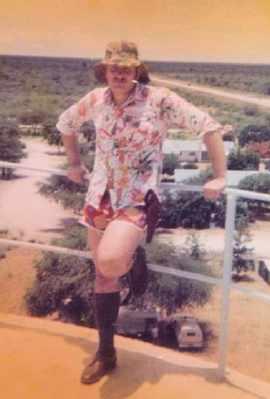
Die outeur by Oshivelobasis.

wat ek die voorreg gehad het om ooit te kon deurloop. Die toepassing van die opleiding in die jare wat gevolg het, was van onskatbare waarde.
OPGEDRA AAN INSTRUKTEURS VAN DIE SPESIALE TAAKMAG :
LUIT. PHILLIP DELPORT
LUIT. GRANT GRIERSON
A/O RONNIE BEYL
SERS JOHAN LOTRIET
HOOFSTUK 19
PLOFSTOFDESKUNDIGE Ek het opdrag gekry dat die BO van die Grens Afdeling, Oos–Londen, my dringend wou spreek. Wat het ek nou weer gesondig, was die eerste gedagte wat deur my kop gemaal het. Die posbevelvoerder het ook niks gesê nie en die wat weet wou nie praat nie. Met my aankoms by die kantoor het die BO heel vriendelik gelyk en ek het moed geskep. Dalk was dit nie so sleg soos ek vermoed het nie. Die bevelvoerder het egter nie vir lank so vriendelik gebly nie! Ek word selfs tee of koffie aangebied! Nou worry ek - wat gaan hier aan? Die BO deel my soos volg mee: “Jy is net die regte persoon vir die taak en dit was eenparig besluit dat jy die afdeling se toekomstige plofstofdeskundige gaan word en weggestuur gaan word vir die nodige opleiding. Verder het ek ook die goeie nuus dat jy gaan ’n groot bedrag geld in die vorm van ’n plofstoftoelaag kry, elke maand R200.00”! Ek sien my
vrou en twee pragtige kinders voor my geestesoog. Ek sien ook die Limpet-landmyn wat ek moet ontlont of verwyder. Ek onthou die spanning, die vrees, en ek sien die sweet op die aangesigte van die S.A. Polisie se plofstofdeskundiges tydens die ontlonting van kleefmyne waar ek al verskeie kere teenwoordig was, en ek word stil. Die BO het gevra of daar ‘n probleem was en of ek dan nie opgewonde was oor die aanbod nie? Of ek miskien bang was? “Nee”, antwoord ek, “bang is ek beslis nie, EK IS VREK BANG! Nee dankie, ek aanvaar nie die aanbod nie!” Die groot EER / TOELAE word aan ’n ander dapper/dom Sersant toegeken!
HOOFSTUK 20
BEWYSSTUKKE Daar het ‘n vakature by die Mobiele Eenheid, King William’s Town, bestaan. Ek het aansoek gedoen, en was ongelooflik gelukkig om die pos te kry. My verloofde was daar werksaam en woonagtig. Die gebied wat deur die Mobiele Eenheid gepolisieer was, het geweldig uitgebrei en verskeie dorpe ingesluit. Op die betrokke Vrydag het ons om 13:45 aan diens gerapporteer, en 22:00 van diens gegaan. Om ongeveer 21:15 het ons (dis nou my sersant en ek) Blaney
Spoorwegstasie wat ongeveer 15 kilometer vanaf King William’s Town en naby die dorpie Berlin in die Oos-Kaap geleë is, besoek. By ons aankoms aldaar het ek ‘n bakkie wat langs die platform geparkeer was gewaar. Ek het ook opgemerk dat die bestuurder van die voertuig geskrik het toe hy die polisievoertuig gewaar het. Ek het die sersant versoek dat ons
Tyd om te ontspan - Oshivelo

gou die voertuig deursoek. Onwillig en baie ongeduldig het hy my meegedeel dat ons in 45 min van diens gaan en dat hy nie nou lus het vir nonsens nie. Ek het egter voet by stuk gehou en die verdagte voertuig genader, terwyl die sersant in die polisievoertuig agtergebly het. Met my aankoms by die voertuig het ek opgemerk dat die bestuurder iets onder die sitplek uithaal en ek het besef dat ek dadelik sou moes optree. Ek het die deur van die bestuurder oopgepluk en geskok waargeneem dat dit ‘n MOERSE GROOT vuurwapen
was wat hy in sy hand gehou het, en dat die loop van die vuurwapen op my gerig was! Instinktief het ek op die bestuurder geduik en daarin geslaag om na ’n geworstel hom te ontwapen. Die bakkie was deursoek en tot ons verbasing was daar groot hoeveelhede sakke vol dagga (cannabis) asook vuurwapens en ammunisie agter in die bakkie gevind. Groter was die verbasing nog toe daar steeds geheg aan die sakke dagga bewysstuk-etikette van die Mdantsane Polisiekantoor gevind was! Verdere ondersoek was ingestel en dit het aan die lig gekom dat daar by die Mdantsane polisiekantoor ingebreek was en dat die inbraak nog nie eers ontdek was nie. Al die goedere, vuurwapens, ammunisie en dagga was bewysstukke in ‘n saak wat nog in die streekshoof moes dien.
HOOFSTUK TWEE
Deurnag word ek ʼn paar keer wakker en elke slag besef ek ek is op pad om my roeping te gaan uitleef. Dis koud maar nie so erg nie. Die verwarmer het die kompartement waarvan die deur toe is so effe warm gemaak. My reismaat haal reëlmatig asem—ʼn aanduiding

Na ons Noupoort verlaat het,
dat hy lekker slaap. Ek word gewek deur ʼn geklop aan die kompartementdeur en iemand wat roep “Oggendkoffie?” Destyds het passasiers vroeg in die oggend ʼn koppie koffie gratis gekry. Dit was bedien deur ʼn kelner wat in ʼn swart broek en wit hemp en baadjie geklee was en ʼn strikdassie gedra het. Hy deel ons mee dat ons nie meer ver van Noupoort af is nie. Om en by agtuur trek die trein Noupoortstasie in. Die ryp lê spierwit op die platform en toe ek die vensterruit laat sak voel ek die ysige koue. Twee rangeerders loop op en af langs bewaarder wat weer sy uniform het die bewaarder in die eetsalon gaan eet en ek het die padkos wat tant Kang ingepak het nader getrek. Sulke padkos smaak mos baie lekkerder as dieselfde kos wat tuis geëet word. Die dag voel later langer as ʼn nie en ek sit maar by die venster en uitkyk na die vlaktes wat verby rol. By Colesberg staan die trein langer as by ander stasies. Ek verneem die lokomotief neem water in. Die son sak in die weste toe ons by Trompsburg, Redders-

die trein en bekyk my en die burg en Edenburg verby ry op
aan het. Een van hulle kom later by die venster staan en vra wraggies vir die bewaarder “pas jy die outjie op?” Min kere in my lewe het ek so verleë gevoel soos daardie oomblik.
Bloemfontein stasie circa 1950’s (© Les Pivnic, met sy toestemming gebruik)
jaar. By elke stasie en halte stop die trein, word melkkanne in en uitgelaai en hier en daar klim ʼn passasier op of af. Die bewaarder en ek het later niks meer om vir mekaar te vertel pad Bloemfontein toe. As ek sê ek het toe nie huistoe verlang nie sal ek jok. Ek dink aan my ouers, oupa hulle en selfs die honde op die plaas.
Dan dink ek weer aan my loopbaan wat lê en wag en die nuwe vriende wat ek gaan ontmoet. Maar omdat ek nie weet wat vir my bestem is nie kan ek ook nie te ver vooruit dink nie. Al wat ek op daardie tydstip aan dink is dat ek dalk Port Elizabeth of Uitenhage toe gestuur sal word en nader aan die familie sal wees. Min het ek kon dink dat dit eers meer as tien jaar later sal gebeur. Net na 8 uur die aand van 7 Junie 1954 stoom die trein Bloemfonteinstasie binne. My mond moes seker oopgehang het want so groot stasie het ek nog nooit gesien nie en nog minder soveel elektriese ligte. Dis die een aankondiging na die ander. Daar word aangekondig dat die trein langs perron 1 die trein vanaf Port Elizabeth op pad na Johannesburg is. Die rytuie waarin ons is word afgehaak en aan ander gekoppel- dit is as ek reg onthou. Kort-kort kom die aankondiging dat die trein langs perron een om 9 uur na Johannesburg sal vertrek. Ek is opgewonde want ek besef dat oor ongeveer twaalf ure sal ek in Johannesburg wees en vir neef Faan sien. Ek kyk nog n slag of ek die koevert waarop sy en sy swaer se besigheidsadres deur my ma geskryf is in my sak is. Ja dit is. Die adres 119A Julesstraat, Belgravia, Johannesburg. Die trein reis nou teen ‘n spoed wat my as plaasseun laat bang word. Om draaie lyk dit of die wa oorhang en dan weer regop kom. My reismaat en ek klim maar vroeg in die bed want môreoggend is dit vroeg opstaan, skeer en aantrek. Dan sal ons in Johannesburg wees Ons word weer wakker gemaak deur ʼn kelner wat koffie bedien en daarna is dit skeer en aantrek. Ek onthou ek gaan nou darem in ʼn elite plek afklim en sit selfs ʼn das aan. Terwyl ons Johannesburg nader sien ek vir die eerste keer mynhope. Ek vra vir die bewaarder wat se snaakse berge dit is en hy vertel “nee maat, dis mynhope daardie.” Dit is toe dat ek regtig begin twyfel aan my besluit om na Sodom en Gomorra, soos tant Kang Johannesburg genoem het, te gaan. Maar dis te laat en ek kan nie omdraai nie. Ongeveer 36 uur nadat ek Port Elizabeth verlaat het trek die trein stadig Johannesburg stasie in. So iets het ek nie in my wildste drome verwag nie. Soveel mense bymekaar het ek ook nog net gesien toe ek ʼn rugbytoetswedstryd in die Baai gaan kyk het. Terwyl die trein die stasie binnekruip soek my oë na Faan maar daar is geen teken van hom nie. Ek bekla my lot teenoor my reismaat wat sonder meer sê dat hy my tot by die huurmotors sal neem waarvandaan ek dan maar een moet neem na die adres wat ek het. Om ʼn lang storie sommer baie kort te maak die huurmotor- ʼn ligblou Hudson Hornet - se drywer kyk na die adres op die koevert en daar trek ons. Maar my dierbare ma het die adres as 1194 geskrywe in plaas van 119A en die “A” soos ʼn vier gemaak. Ons is later in Germiston en die meter in die kar loop. Die drywer vra my die naam van die plek waar ek vir Faan sal kry. Dis Juliana Tea Room op die hoek van Berg- en Julesstraat. Hy neem my sonder meer soontoe en ek skuld hom negentien sjielings en n sikspens (een rand vyf en negentig sent). Ek is so verlig dat ons uiteindelik by die regte adres is dat ek hom sommer twee rand gee. Ek maak die storie weer baie korter. In die besigheid ontmoet ek Faan se swaer, Jan Dippenaar. ʼn Joviale, vriendelike man wat sommer dadelik meedeel “Faan sal sommer nou -nou hier wees - hy het iets dringend gehad om te doen”. Terwyl ek aan ʼn lekker koppie koffie sit en teug kom Faan daar aangestap. Blye weersiens. Jan bied aan dat ek voorlopig by hom en sy vrou, Cillie en sy ma kan intrek. Waaraan ek ernstig dink is dat ek so gou moontlik by die spoorwegpolisiehoofkantoor in Pleinstraat moet aanmeld. Faan praat my om om eers die volgende dag, Woensdag te gaan want dan kan konstabel De Winnaar wat by hom en Babs loseer saam met my gaan. Daardie middag pak ek my klere uit in ʼn hangkassie wat in ʼn redelike klein kamertjie staan. Ek is dankbaar want ek het ten minste blyplek. Cillie is swanger met hulle eerste kind maar is soos n moeder vir my. Faan stuur n boodskap aan my ouers dat ek veilig aangekom het. Ons gesels oor alles in die familie en daardie aand slaap ek na twee aande nie in ʼn trein nie maar ʼn enkelbedjie..
by Frans Bedford-Visser
You may ask yourself, “What is the significance of this photo?” Why would a Railways Policeman be participating in a memorial service for fighting men? That is really an over-simplification, but one which accepts that the general public were, and still are, unaware of the great service offered by the members of the Police Force. Oft overlooked or joked about as being “Station flowerpots” or “Stasie blompotte”, the South African Railways Police has proud origins, serving the Nation in many ways.

Following the re-organisation in 1934, when the South African Railways and Harbours Police was given recognition as a fully-fledged police force, responsible for the detection and prevention of crime, not only on the Nation’s railway network, but in fact at all ports, land, sea or air. They rigorously defended the Nation’s transport network, including all ports of entry into South Africa. This was of course
Embroidered emblem of the South African Railways and Harbours Brigade

Constable J.B. Uys of the Railway Police salutes at the South African Railways and Harbour War Services Union annual Remembrance Day ceremony at Cape Town Station in 1982 to commemorate Armistice Day - the end of World War 1. Wreaths were laid after the playing of the Last Post and a two-minute silence. Picture courtesy of the African News Agency archives. africannewsagency.com only a few short years before the outbreak of the
Second World War, and following the declaration of war, many men from the Railways and Harbours, including Police, joined up with the Union Defence
Force as part of the South African Railways and
Harbours Brigade.
The following SAR&H officers are mentioned in the book "We Fought The Miles" - Published by Authority of the Gen Manager of the SAR: Const JM Riekert—KIA Maj AD Cillliers (Sub-Inspector)—Awarded the Military Cross (British medal of valour) Lt CJ van der Merwe—Awarded the Bronze Star (American medal of valour)
South Africa's armed forces were small, and their The article which follows is subject to the license material resources meagre, when the country below and credit has been accorded as required: entered the Second World War on 6 September “This is an electronic version of an article pub-1939. The Permanent Force was nearly 50% lished in Scientia Militaria, Volume 5, number 2, under strength; the shortage of trained infantry- pages 66–75”, men was estimated at over 39000; ammunition for artillery pieces and anti-aircraft guns was DOI: https://doi.org/10.5787/5-2-891 sufficient for one day's shooting, and only two ob- (http://scientiamilitaria.journals.ac.za) solete armoured cars were available. Two experimental armoured cars had been built locally. During the first years of the war it was not This work is licensed under a Creative Commons possible to obtain much equipment from the Attribution-NonCommercial-NoDerivatives 4.0 InUnited Kingdom or the United States. Local ternational License. ingenuity was heavily taxed as attention concentrated on preparing the South African armed forces for long campaigns. Gradually The following license applies: regiments were mobilized and equipped, and an Attribution CC BY-NC-ND 4.0 extensive munitions production drive was launched.
SA infantry in the northern desert during WW2. Credit: South African Military Veterans Organisation of the USA on Facebook



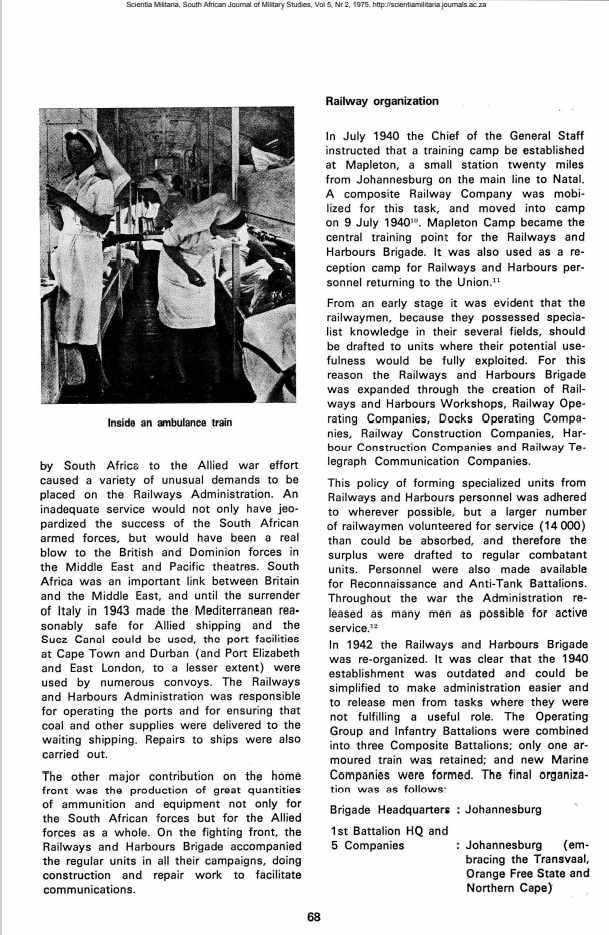












P W L SMIT

deur sy dogter, Martha van Rensburg

PWL Smit (Speedy) op sy troudag 28 Jan 1956, regte Sporie troue, strooijonkers Charlie van der Merwe, Beukes (kan nie sy naam onthou) en Piet Cronje.
Martha van Rensburg, dogter van geliefde S.A. Spoorwegpolisieman, PWL ‘Speedy’ Smit, het die foto's van haar Pa ingestuur. Kommentaar is gelewer deur sy oudkollegas wie hom geken het. Kommentaar: Martha van Rensburg: Sal interessant wees om te weet wie saam my Pa “Speedy” gewerk het, Tafelbaaihawe, Kaapstadstasie, Nyanga, DF Malan lughawe ook gewerk Hy het ook bynaam Kreef gekry in hawe, ons kinders weet van kreef, tuna, kingklip en snoek, na normaal skof oortyd gewerk, dan op snoekbote uit gegaan om vis te vang, by Nyanga het hy groentetuin gehad, ons altyd vars groente gekry
Michael Koegelen-
berg: Martha van Rensburg wel ek het vir ‘n lang tyd saam met hom gewerk by Platform 1. Het baie keer hom huistoe gery en in die oggende weer opgelaai as ek sy motor nodig gehad het om mense naure te gaan sien het vir verklarings ens. Deon Huysamen Het saam met Speedy gewerk by Athlone Distrikshoofkantoor, Athlone na die amalgamering. Ons kantore was langs mekaar en Speedy het tydens die ete-pouse sy deur toegemaak en op die mat gaan lê en rus. My taak was om teen die muur tussen ons kantore te klop sodra etenstyd verstryk het. Ek dink ek was die enigste een wat van hierdie gewoonte van hom geweet het. Was 'n regte mens-mens.
Leon de Roubaix -
Martha van Rensburg: Hy was my SB in 1983 in die hawe.
Wilhelm Ackerman -
Martha van Rensburg, hy was op Langa-stasie. Baie daar besoek toe ek op die mobiele eenheid op Bellville was, Piet Campher het jou pa 'n senuwee ineenstorting gegee party dae, veral op nagskof het Piet enige ding aan gewerk sommer daar op die tafel in die aanklagkantoor, tot sy Peugeot se enjin daar geoverall. Lekker tye.
Nicolaas van der
Merwe: Dit was ‘n voorreg om saam met hom te kon werk was my bevelvoerder in Tafelbaai hawe 1982 Johnny Smit: Het saam met hom gewerk op Kaapstadstasie, 1983.
Eugene van Rhyn:
ook my sersant Was
Paul Johannes
Brand: Ek het ook saam met hom gewerk op Kaapstad
Bennie Van Zyl:
met hom gewerk Ek het saam
Henk Fourie: Ja die een heel links lyk na Spyker van der Merwe wat voor aftrede op die lughawe gewerk het. Jaap Coetzee: SAAM MET JOU PA GEWERK OP BELLVILLE MOBIELE EENHEID EN OOK SO TYDJIE OP DIE UNIFORM SKOFTE. GOEIE MENS GEWEES EN ALTYD N PLAN
P W L SMIT (SPEEDY) op sy troudag 28 Jan 1956

GEMAAK AS JY N PROBLEEM GEHAD HET. REGTE MENS SE MENS. Martha van Rensburg: Dalene Etzebeth Hough by Pa het AL die Etsebeth's geken, Harry nog vriende met Leon en Estelle Louw, Koos het net voor hy oorlede is by my Pa op plaas in Clanwilliam gekuier
Martha van Rensburg ek het ook saam met hom in die hawe gewerk in vroeg ‘70s. Sy skof het gewoonlik by ons oorgeneem. Onthou ook hoe hy saam met die snoekskuite uitgegaan het. Herman Bosman: Speedy het my geleer van allerhande wilde
veldplante in die natuur wat geëet kan word - oa veldkool. Ons het op skof in die bos rondgekruip en ons pette vol veldkool gepluk...hehehe.


Bo: PWL Smit (SPEEDY) op sy troudag 28 Jan 1956

Links en onder: Saam met sy gade gedurende ‘verskeie funksies

Links Bo: Speedy Smit as jong konstabel (heel links)
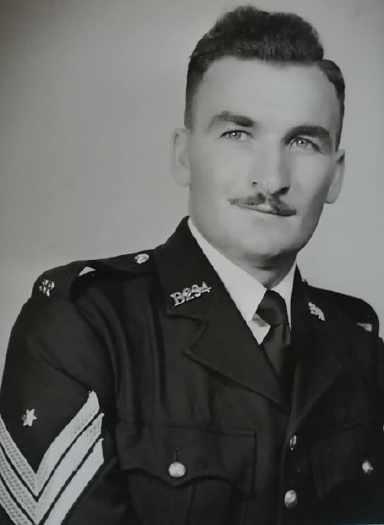

Regs Bo: Speedy Smit as Sersant in 1956 Onder: As Posbevelvoerder in Kaapstad—Circa 1984

Bo: Groepfoto: Lede van die Mag te Kaapstad, 1984 (Speedy Smit sit links voor.) - Krediet: S.A.S.P. Gedenkalbum Onder: Speedy Smit en gade, kol Lourens en gade, kol IJ Mostert en sy gade en Mcgregor en sy gade

Gjh Lieb Koekemoer: Toe ek in 1981 die Seksiespeurder te Klawer was, was Mac die Seksiespeurder te Saldanha. Sy seksie was vanaf Saldanha tot voor die groot brug oor die Olifantsrivier tussen Vredendal en Lutzville, en

myne vanaf die brug tot by Kenhardt. Nico Gunter Mooi foto. Het saam met al vier by die Spoories gewerk.



DURBAN CITY POLICE DOG UNIT

The Durban City Police Force (DCP) was originally established in 1854 as the D’Urban Borough Police (DBP). The name was changed to the Durban City Police when Durban was established as a city in 1935.

From the establishment in 1854 until the amalgamation of the Durban City Police with the local law enforcement in July of 2000, as the Durban Metropolitan Police Service in terms of the South African Police Act with the police functions including the enforcement of crime prevention (deterrent and/or suppression of crime), traffic management and the cities by-laws. As the City did not have a functioning police dog unit, applications for its establishment were applied for and submitted for approval several years prior to 1995 and on numerous occasions by Dep-
Kenneth Verwey - (DMPS Supt. / Lt. Colonel) – Retired
uty Chief Constable Lance McGregor-Stewart (DCC) and Senior Sergeant Kenneth Verwey. It would appear that there was some reluctance or hesitancy in the establishment of this Unit. The main reason for the dog unit is the attributes of dogs in being able to actively assist in crime prevention, to seek out narcotics and explosives, the apprehension of criminals in remote areas where thick vegetation is difficult as well as urban buildings. Their unique sense of, smell, eyesight and agility being their main advantage.
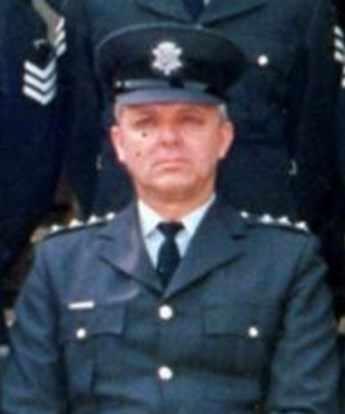
In a management meeting held at the Durban Council Protection Services Department, Deputy Chief Constable Lance McGregor-Stewart (DCC) again suggested the formation of the Unit and it was again dismissed. At the same meeting, the head of the Council Protection Services, Lieutenant Colonel Mike McKenna accepted full responsibility for the initial idea of the Unit, thus dispelling all the negative arguments for the unit. These initial responsibilities included insurance for the animals, claims against the department, kennelling, medicals, feeding, transport and training.
(Continued from page 123) way to be seen as taking over the functions of the SAPS, but rather to augment and enhance As a result of this commitment the unit was given cooperation in the joint fight against crime. the green light to be established. The recommendations and agreements were tabled at Council and was agreed to and in1995 the Durban City Police established their first Dog Unit. The unit consisted of 20 members, and were kennelled at the Durban City Council Protection Services Kennels and the Durban City Council Electricity Department Substation situated in Kenyon Howden Road, Montclair. This was the first time a Municipal Police Dog Unit was established in Durban.

S/Sgt. Kenneth Verwey

With this in mind S/Sgt. Verwey made contact with the Provincial Head of the SAP Dog Unit, Colonel Dana Kruger, who indicated that he was very willing to assist in the establishment process and gave us his full cooperation. This decision was also based on the fact that more police coverage results in the possibility of less crime being perpetrated.
Lt. Colonel Mick McKenna (BSA Police)

Then Senior Sergeant Kenneth Verwey was appointed to establish the Durban City Police (DCP) Dog Unit in its entirety due to his police knowledge and experience. The task ahead was challenging however he was able to glean information from a very will assistant in the South African Police Force. The South African Police Force Dog Unit had been in existence for many years and it would be an advantage to take away all the good attributes of this unit and create a functional and effective unit for the City of Durban. It was made abundantly clear from the unit’s inception that this was in no
Colonel Dana Kruger
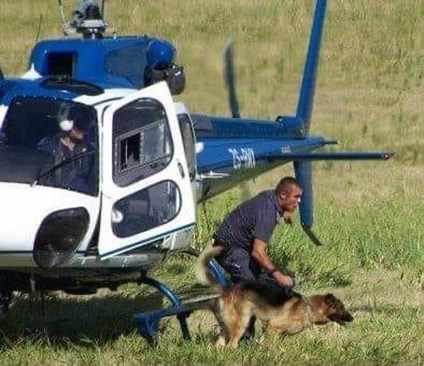
PC A. Chappen This mutual cooperation between the Durban City Police and the SAPS regarding all aspects of the training, equipment, vehicles, feed, medicals, kennelling, training and shifts resulted in the completed Standard Operating Procedure and Force Orders by S/Sgt. Verwey, which in turn became the blue print for the continued success of the Unit German Shepherd There was a debate as to which breed of dog would be most suitable in the Durban environment to operate within the unit. Following in

PC N Jansen
depth discussions with Colonel Kruger and top management, the decision was taken to employ the services of German Shepherds as they were most suited for crime prevention and attacking crime full on, which seems to be at the most, a global police decision. The main reason for the utilisation of the German Shepherd globally, is that they are faster, more agile and have a higher level of endurance than a Rottweiler, as an example.
They are extremely sociable, versatile and adaptable animals in that they are used for police work in many areas such as patrol, explosives, public relations, cadaver, search and rescue and they
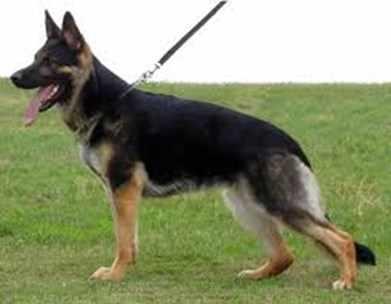

Rottweiler
develop a very strong bond with their handlers.
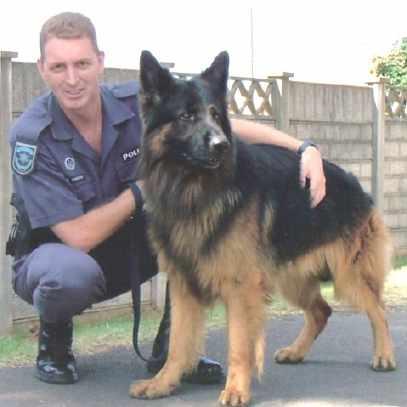
PC W Hammond
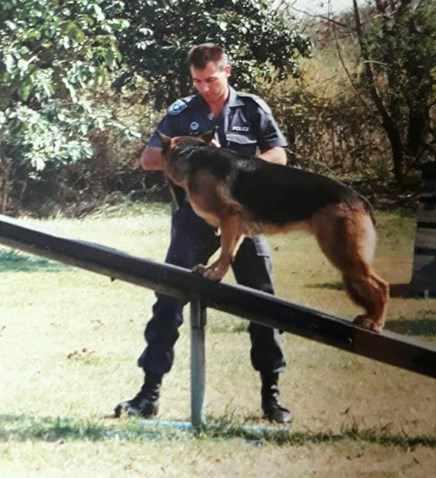
Assistant and PC D Newcombe with tackling training

As far as training was concerned S/Sgt. Verwey investigated the possibility of securing in-house police dog training. This would necessitate a request for an instructor to be trained by the SAPS Dog School in Pretoria, as mandated. The unit was very fortunate that Mitch Mitchley, the Dog Trainer from the Council Protection Services was an experienced dog training instructor and had been working since 1985. He was sent on a course to the SAPS Dog School and was certified by them to train the DCP dogs. They would however be evaluated and passed by a members of the SAPS Dog School before they would be permitted to become operational. The tedious process of advertising internally for members who showed interest commenced, a preliminary interview was held and all members’ records were obtained before the final interview. One of the main criteria of the prospective appli-
PC E Jardine
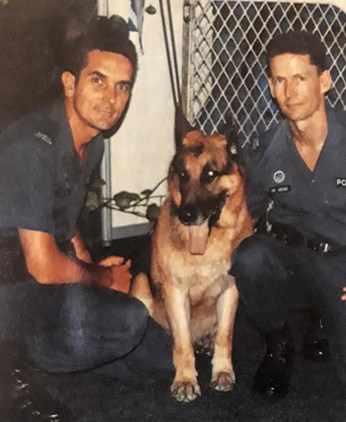
cants was that they had to be animal lovers and
PC D Newcombe and Sgt. G Mooney
have the necessary patience and tolerance in order to correctly and compassionately care for the animal, conform to all the requirements. Members who had a bad sick leave and disciplinary record were not considered.

Once the preliminary list was drawn up their fitness abilities were then tested. Those who could not pass were given a time period to achieve the criteria’s of the fitness test (depending on the availabilities of the scheduled training courses). Failure to pass the final fitness test resulted in exclusion Above and below—PC D Newcombe and PC T Lyle) from continued participation in the selection process. circumstances when the owner of the dog is afraid of the dog because of its aggressiveness. Those that complied with all the requirements were interviewed by a selection panel and the most suitable were selected and transferred to the Once the dogs had been acquired they went Dog Unit. through a medical and thereafter a scientific test Suitable dogs have in the past been obtained through donations and under certain to identify its “controlled” aggression capability. The dogs were also placed on a medical aid to assist and provide much needed treatment when required. The SAPS Dog Unit at the central SAPS station also had a veterinarian who assisted from time to time, under emergency situations only.
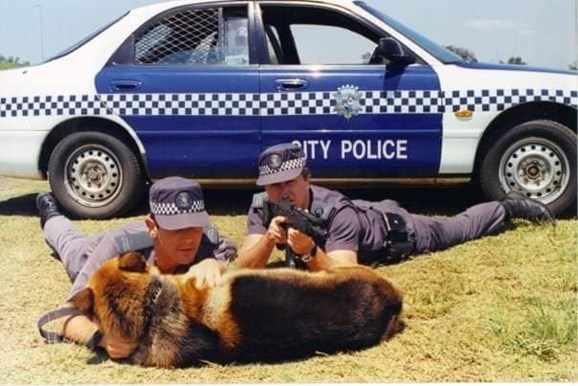
Depending on the temperament of the dog it would be assigned to a category best suited to take advantage of its natural ability. If the dog had the capability of controlled aggression and a good sense of smell, it would then be assigned to a handler in
the patrol and tackle category. If the temperament was docile and very friendly it would be assigned to the display and public relations section or if the dog was docile and indicates that it had an exemplary sense of smell and a tendency to actively utilise this attribute then it would be placed under the narcotics section. Initially, a new dog was paired up with a handler and it was expected that the pair become fully acquainted with each other and bonded as a unit. Once the bonded unit was established they were sent off for the next step of the training. Training as a dog handler is a concise 4 months course which is training in the application of dogs as a crime prevention tools, theory and practical’s, as well as veterinary care of the dogs. Once a dog has bonded with a handler and they have completed the course successfully the dog became a member of the Durban City Police and is assigned a Police Patrol Dog (PPD) Force No., such as PPD 11 – Bruno. Police Patrol Dog Force No. The dog then becomes a servant of the city. After the Patrol Dog Handlers four month Training Course there is a further three week Tactical Dog Handlers Course. Patrol Dog Handlers course training Curriculum, in general covers the following:buildings, Practical tracking, Searching for articles and Retrieving an object, Follow a human trail and indicate what objects contain a human scent at a crime scene. o apprehend fleeing, dangerous, armed suspects and find possible scented objects.
o
avert and apprehend dangerous, armed suspects. Specialised Narcotics Dog Handlers Training course is a five month course and an additional two weeks for the tactical Dog Handlers Course.
Patrol Dog Handlers course training Curriculum, in general covers the following:• Obedience, Searching for substance(s) in vehicles, buildings, containers, underground and pavilions, Searching for substance(s) in open areas Tactical Dog Handlers course training Curriculum, in general covers the following Legal Aspects:• Private Defence

o
o
Use of force (section 49 of the Criminal Procedure Act, 1977 (Act No 51 of Search and seizure Weapon‐handling skills o Shooting fundamentals
• Obedience, Apprehending armed/dangerous suspects Searching for suspects in an open area or 1977)),
o
Safe direction Safe making, loading, assembling and disassembling a 9mm handgun, an assault rifle and a shot gun. The carrying conditions and the shooting positions of a 9mm handgun, an R5 assault rifle and a shotgun. The continued suitability for a qualified dog and handler depends on continual in service training, fortnightly training (short assessment), three monthly (full assessment)’ and biannual full assessments. In an event that the dog handler or dog are not successful in any of the three monthly or biannual assessments, they are taken off operational duties and reverted back to training for a 10 day retraining program.
Dog handlers have the obligation to regularly train and exercise their dogs and to seek assistance to this end when required. On the successful passing of the above courses, the Dog Handler is awarded the traditional and well know work symbol of achievement - the Dogs Head Badge. S/Sgt. Verwey identified the need to have joint operational training with the SAPS dog Unit from time to time. He discussed the matter with captain Shane Thompson, the officer commanding the Durban Dog unit based at the SAPS Central Police Station. Jointly (SAPS and DCP) identified areas of weakness and/or requiring more training were sought out and programs was developed, and the members tasked to attend as they were, (to emulate a real life exercise). Operationally the two forces worked very well together and became an effective entity against crime and in the prevention of crime. This was also achieved through the use of each other’s police radios (which was installed by the SAPS radio section into the DCP vehicles), based on a world known fact that “communication is everything”. It was not uncommon that DCP Dog Units were dispatched directly to attend complaints and provide assistance from the SAPS Radio Control. Each DCP dog handler was assigned a SAPS Call sign and was expected to sign on and off the

PC newcombe with narcotics dog Jessie
SAPS radio when signing on and off duty. To ensure that the dogs were cared for and their interests were met S/Sgt Verwey facilitated that an open letter of intent be drawn up and delivered to the Society for the Prevention of Cruelty to Animals (SPCA), giving them full permission to enter and inspect the dogs at the kennels or at any location where the dogs were kept or utilised at any time, without notice. This decision was to provide some outside inspection and oversight or third party involvement, to ensure that the animals and their living environment under the care of the DCP was up to standard and any shortfalls were dealt with immediately. For this the SPCA service was appreciated.
Anglo Boer War: Colourised Photographs Jennifer Bosch


The “Big Three” of the British Field Marshal Roberts, Cecil John Rhodes and Field Marshal Kitchener
Members of Boer Families held in Peniche Portugal – ABW Museum Bloemfontein: Photo N Moolman


The “Boer Big Three” - Generals CR de Wet, Koos de la Rey: Photo N Moolman

Hollanders on Commando
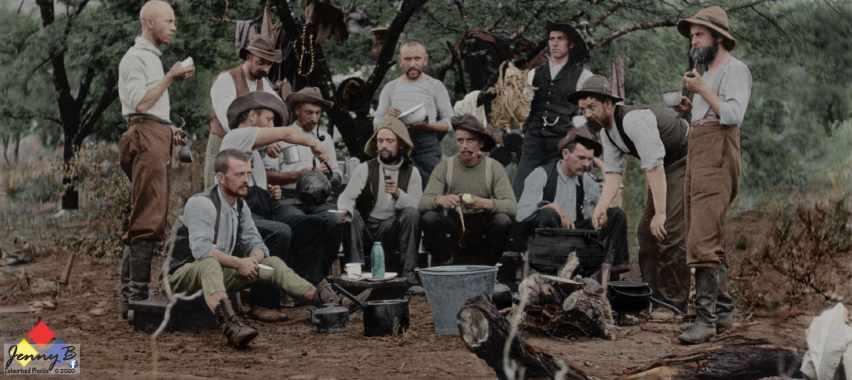

General Piet and Mrs Hester Cronje, POW’s on St Helena
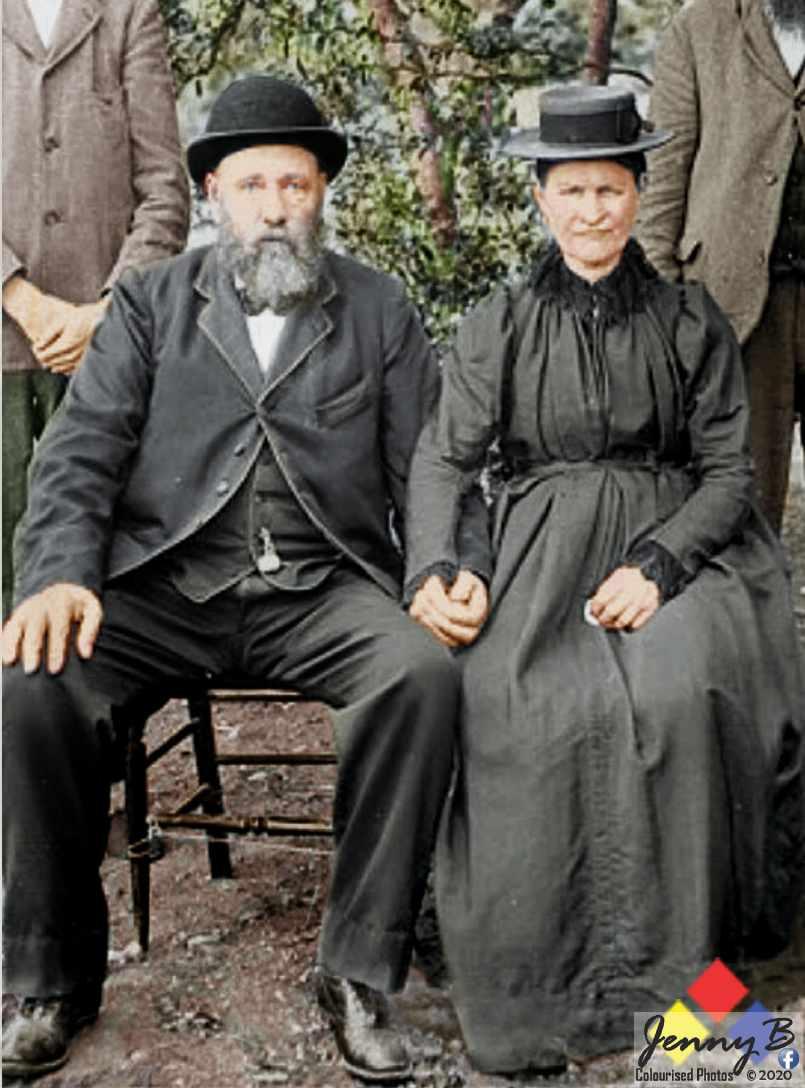
Field Cornet T Donges and Lukas his trusty Agterryer


A then and now blend -
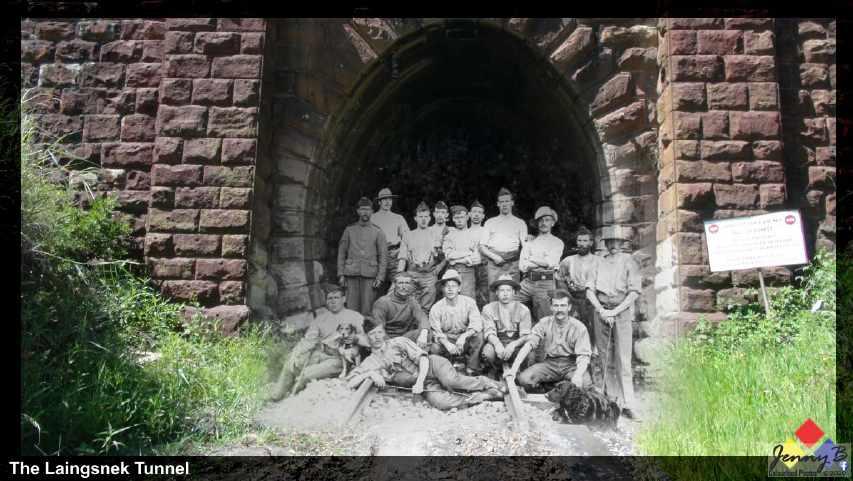
Laingsnek tunnel

Capt J. de Vries
Goeienaand Brig Heymans hard Kamffer of a Memorial to Boer officer, gense onthulling van die generaal Koos De La Reystandbeeld. presentations on a wide subject cross section releeral, parliamentarian and senator Jacobus HercuGroetnis van Pretoria Oos. laas (Koos) de la Rey (22 October 1847 – 15 SepSien asb. aangeheg die MS Word weergawe van Army (C Army) Lieutenant General Lindile Yam to die Reserve Force Volunteer artikel oor brig-genl Brig Gen Kamffer for the unveiling of this memorial Kamffer se deelname aan Kedar Heritage Lodge in his capacity as Director Army Reserves. tember 1914). Permission was granted by Chief In the speech COVID-19 het so bietjie in die pad gestaan, maar he delivered ek wil graag weet of ons nog 'n interview of twee after unveiling met Genl Kamffer en ander soos the General Fransjohan Pretorius kan voer om die artikel vir die Koos de la Rey NONGQAI kan voorberei? Dit en die feit dat die Memorial with Reserwemag regiment in Potchefstroom steeds Executive Generaal De La Rey se naam behou en se erfenis Chairman of bewaar. Recreation Africa Group Mr Met dit wat in die artikel is, wat korter gesny en Robert Foraangepas kan word, sou ek enige insette waardeer syth, Brig Gen om dit vir publikasie gepas te maak. Kamffer echoed the words Ek hoor graag van u af terug! As ek net ook 'n of the day's selnommer van u kant af kan kry sal ek ook te keynote speakWhatsApp opvolg. er Prof Fransjohan By voorbaat dankie - Pretorius to underscore Koos de la Rey's recognition as one of Jacques de Vries South Africa's great military leaders. Acting in his official capacity on the day as Director of the South Captain African Army Reserves, Brig Gen Kamffer highSouth African Army Reserve lighted the importance of the fact that de la Rey Office of the Director SA Army Reserve was "by all accounts, one of the first in a long line SO3 Research Support Officer of part-time soldiers." Brig Gen Kamffer saw it fitting to "...acknowledge the Minister of Defence and Military Veterans (MOD&MV), Nosiviwe Mapisa-Nqakula, who in Unveiling of General Koos de la Rey Memorial conjunction with C Army Lt Gen Yam and a Name by Director South African Army Reserves Review Steering Committee, recently concluded Kedar Heritage Lodge, Conference Centre and identified General de la Rey, amongst others, as a Spa near Rustenburg in the North West Province fitting South African hero, to be honoured. Regiused the occasion of the one hundred and twenty- ment De La Rey, one of our distinguished Reserve year commemoration of the South African War units, will not only retain its name but will hence(also known as the Second Anglo Boer War) of forth be known as General De La Rey Regiment, 1899 to 1902 to host a conference on the subject an infantry rifle battalion, on the SA Army Order of from 19 to 20 October 2019. This event comprised Battle." the name review process in the SA Army, that vant to the South African War, anchored on 19 Oc- He elaborated on the name change process antober by a Keynote Address by Professor Fransjo- nounced by C Army on 7 August 2019, saying - "In han Pretorius entitled "The Life of General Koos de this small way, we, as the SA Army, seek to forla Rey" and the unveiling by the Director South Af- mally recognise the outstanding performance of rican Army Reserves Brigadier General (Dr) Ger- (Continued on page 137)


Gen de la Rey as a military leader, and the significant role he played in South Africa’s vibrant history. In the process of paying homage to him, we also ensure that we preserve our military heritage and the legacy of this respected, Boer War general." Gen Kamffer spoke of Koos de la Rey’s aptitude for leading from the perspective of the 'Levels of War'. The National Strategic Level; Military Strategic Level, and the National Strategic End-State of the Strategic Level of War are divided into different theatres of operation where the military strategic end-state is won or lost. The Operational Level of War sees battles fought at the tactical level to reach an Operational end-state. De la Rey gained experience and insights at all these levels of war, from his service in the 1st Anglo-Boer War (1880–1881). His appointment as Combat General (Veggeneraal) on 19 October 1899 allowed de la Rey to exert considerable influence on both the tactical and operational levels of war. Learning from lessons at the Battle of Graspan on 25 November 1899 he modified tactics leading to Boer victories over British opposition at the Battles of Modderrivier and Magersfontein on 28 November and 11 December 1899. Following the turn from the conventional phase of the conflict after the Battles of Donkerhoek and Diamond Hill east of Pretoria from 11 to 12 June 1900 to one of Boer guerrilla warfare and British scorched earth counterinsurgency tactics, Kamffer references de la Rey as one who optimally used "...the operational factors of time, force, and space" that distinguished him as outstanding military commander. "He demonstrated, time and time again, that it was his ability to concentrate superior forces at critical junctures, that ensured Boer tactical victories at battles such as Silkaatsnek, Nooitgedacht, Moedwil and Tweebosch, where he defeated and captured Lord Methuen" whom de la Rey gave safe conduct to British lines for better medical treatment. De la Rey's honourable conduct towards his British battlefield counterpart reinforced his reputation as a well-rounded commander who Kamffer states "understood the strategic importance of acting within the laws of armed conflict." Notable papers presented over the two days, on 19 October by Mr Tokkie Pretorius with "The Importance of an inclusive Approach to Preserving the History of the South African War"; Prof Bernard Mbenga describing "The Bakgatla-bagaKgafela during the South African War"; Kedar Lodge manager Mr Andre Wedepohl who spoke about "The Magaliesberg Battlefields Tourism Route" concluding on 20 October with Dr Arnold van Dyk speaking on "The "Bittereinder" Ministers and Spiritual Support on Commando." Kedar Heritage Lodge boasts a number of memorials and life-sized sculptures around its property honouring prominent South African personalities. Designed and executed by architect Nico Wessels and sculptor Adam Madebe, includes the likes of Bafokeng king Khosi Lentshwe I, who fought the British during the South African War; South African statesman General Jan Smuts, who in the name change process is commemorated in General Jan Smuts Regiment (formerly Regiment Westelike Provincie); Mahatma Gandhi who led an ambulance corps that served at the Battle of Spioenkop; Sol Plaatje, who served as a court interpreter during the Boer siege of Mafikeng; Kgosi Mokgatle and Boer president Paul Kruger, who maintained good relations with each other; and Kedar’s now newly inaugurated statue of Koos de la Rey.
Solomon Tshekiso Plaatje
(1876-1932) worked as a court interpreter during the Siege of Mafeking. He was fluent in eight different languages. His diary is the only known record of the siege by a black person. In 1912, he was a founding member of the South African Native National Congress (SANNC), which became the ANC. Kgosi Lentswe I (1857 - 1924) ruled over the Bakgatla-bagaKgafela Tswana community at the time of the South African War (1899-1902). The Bakgatla fought for the British during the war, and King Lentswe proved himself to be a very capable leader.
Kgosi Mokgatle ruled over the Bafokeng people (one of the Tswana communities) from 1834 to 1891. He proved to be a wise and far-sighted leader. He maintained a good relationship with Paul Kruger and the Boer community in the Rustenburg area. With the assistance of German missionaries, he purchased large portions of land which were found in the early 20th century to have very rich deposits of platinum. Brig Gen Kamffer concluded that Koos de la Rey "skilfully demonstrated a comprehensive insight of all the levels of war" in a conflict that affected all
white, black, coloured and Indian people living in the crossfire or fighting on the side of Boer or Brit,
Remembrance Day "Poppy Day" Wolfgang Witschas
On November 11, 1918, fighting in World War I came to an end following the signing of an armistice between the Allies and Germany that called for a ceasefire effective at 11 a.m. – it was on the 11th hour of the 11th day of the 11th month November 1918. The common British, Canadian, South African, and ANZAC tradition includes a one or two-minute silence at the eleventh hour of the eleventh day of the eleventh month (11 am on 11 November), as that marks the time (in the United Kingdom) when the armistice became effective. Remembrance Day is a Memorial Day observed in and that in the bigger picture of heritage preservation and cultural transformation, de la Rey "can be regarded as one of the great generals of the peri-

od, and a true South African hero.
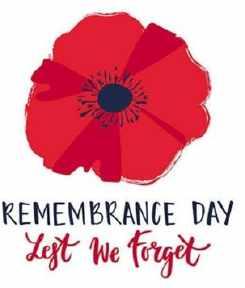
Commonwealth member states since the end of the First World War to remember the members of their armed forces who have died in the line of duty. This day is also known as "Poppy Day". The Service of Remembrance in many Commonwealth countries generally includes the sounding of the "Last Post", followed by the period of silence, followed by the sounding of "Reveille" or sometimes just "The Rouse" (often confused for each other), and finished by a recitation of the "Ode of Remembrance". The "Flowers of the Forest", "O Valiant Hearts", "l Vow to Thee, My Country" and "Jerusalem" are often played during the service. Services also include wreaths laid to honour the fallen, a blessing. The central ritual at cenotaphs throughout the Commonwealth is a stylised night vigil. The Last Post was the common bugle call at the close of the military day, and The Rouse was the first call of the morning.
THE ORIGIN OF WEARING A POPPY
The First WorId War commenced in 1914 and Europe experienced a cold winter over the period of 1914 - 1918. The spring of 1915 (April and May) was warmer than usual and had a positive effect on the vegetation of France and Belgium. In the vicinity of Ypres, the farmers began to plough their fields close to the front line. Poppies (species papaver rhoeas) began to grow on the edges or the ploughed fields. The poppy is an annual plant and flowers during May to August, it propagates itself by seeds that are carried on the wind. When the soil is disturbed, such as when the farmers plough, the seeds are given the opportunity to germinate and grow. Equally the heavy artillery bombardments during the war disturbed the soil and ironically encouraged the poppies to grow, Poppies also grow on the Gallipoli Peninsular and seeds carried by the wind tend to spread far and wide. Poppies also grow in Great Britain. They are prolific during the summer months on the battlefields of the Western Front. The idea of using a poppy as a flower of remembrance was started by an American woman, Miss Moina Michael. She was a member of the YMCA, an organisation that provided facilities for soldiers on the Western Front who were resting behind the lines during the war. On 09 November 1918, two days before the Armistice was declared, Moina was on duty at the YMCA Overseas War Secretaries' headquarters in New York. For military purposes, the traditional night vigil over the slain was not just to ensure they were indeed dead and not unconscious or in a coma, but also to guard them from being mutilated or despoiled by the enemy, or dragged off by scavengers. This makes the ritual more than just an act of remembrance but also a pledge to guard the honour of war dead. The act is enhanced by the use of dedicated cenotaphs, literally Greek for the ("empty tomb") and the laying of wreaths—the traditional means of signalling high honours in ancient Greece and Rome.
Remembrance Day: 2020
Date: Wednesday 11 November 2020 Actual Remembrance Ceremonies Sunday 08 November 2020 Observances: Parades, silences Significance: Commemorates Commonwealth war dead of WWI, WWII and Korean War Observed by: Commonwealth of Nations (except Mozambique). The reason poppies are used to remember those who have given their lives in battle is because they are the flowers which grew on the battlefields after World War One ended. ... Every year, volunteers make poppies available throughout the country and people make a donation in order to get their poppy. In the USA Remembrance Day is celebrated as Armistice Day Future Remembrance Sunday dates: Remembrance Sunday: Sunday, 08 November 2020 Remembrance Sunday: Sunday, 14 November 2021 Remembrance Sunday: Sunday 13 November 2022 Hostilities officially ceased on 11 November 1918 but the last shots that were fired in anger was about a week later as news of the armistice only then reached troops on both sides in the field. Troops deployed to Palestine 1916 against Turkish and German Forces.

Troops deployed to Europe and fought in the Allied Battles on the Western Front in Belgium and France 1916 to 1918. The biggest engagement was in 1916 with the Battle of Deville Wood France, were 2500 South Africans lost their lives.

Combatants
Forces of Imperial Germany (Deutsches Kaiser Reich) United Kingdom Union of South Africa 2500 South Africans died in Delville Wood – who cares?
South Africa's War Commitment
The Union of South Africa’s (1910 to 1961) commitments in WWI and WWII: 1915: Invasion of German South West Africa (DSWA) under General Louis Botha. Troops deployed to German Tanganyika 1916 (Tanzania) under then General Jan Smuts.
South Africa’s involvement in WWII
East Africa: 1940 to 1941 This was an almost all South African army that fought in British Somaliland, Italian Somaliland, Abyssinia and Eritrea North Africa: 1941 to 1943 1 and 2 SA Infantry Battalions South Africa’s, biggest defeat and loss of lives was during the second siege of Tobruk, Libya July 1942. Italy: 1943 to 1944 South African Tank Battalion deployed in the allied
South Africa’s' involvement in Korea: 1950 to 1952 under the Command of the United Nations (UN): SA Air Force (SAAF) Number 2 Squadron, "Flying Cheetahs" Mustang and Sabre fighters
Border War: South West Africa/ Namibia: 1966 to 1989
South African Police (SAP) South African Defence Force (SADF) South African Railways and Harbour Police (SARH Police) South West African Police (SWAPOL)
WE CARE AND REMEMBER THEM FROM 1914 T0 1989 WHO SACRIFICED THEIR LIVES FOR SOUTH AFRICA.
Wolfgang Witschas Sources: Wikipedia: Google: https://en.m.wikipedia.org/wiki/ Remembrance_Day Google: www.rememberance.com Google: https://www.poppyflowers.com

Pathfinder Parachute Group South Africa (Aka SAFFA: South African Falling Fossil Army) by Frans Bedford-Visser
Alhoewel ons nou nie ‘Bats’ is nie, maar gewese SAW, SAP, SA Spoorwegpolisie, en/of Britse magte en/of polisie, het almal in ons groep dieselfde doel, naamlik om met die ronde militêre valskerm te spring, en ons SA-manne wat deelgeneem het aan die tweede wêreldoorlog te vereer deur om op dieselfde DZ's waar hulle gespring het, ook te spring. Ons doen dit drie maal per jaar. Op die Rynrivier in Maart (“Op Varsity”), Junie in Normandië (“Op Overlord”), en September in Arnhem (“Op Market Garden”). Of liewer, ons sou. Ongelukkig is die onkoste om alleen so ‘n gebeurtenis te doen net te veel, so van 2021 af, is dit alleenlik Normandië en Arnhem. Nie te min is dit nóg steeds die moeite werd. Die “eerste valskermsoldaat” van SA se weermag, Kaptein David McCombe.

lived Paratroop Company. Nevertheless, he remained in demand as a paratrooper. Whether this was due to his special skill as a radio signals officer, or his unquestionable thoroughness as a staff officer, or simply because he had connections in high places, can only be surmised. According to his widow, he was 'recalled' to Britain because of his specialist knowledge. Whatever the reason, McCombe underwent a medical examination at Mobile Air Force (MAF) Depot on 24
Ek haal aan: “The Battle of Arnhem David McCombe had never served in the short-

March 1944 and on 4 April he emplaned at Swartkop Air Station: destination - Cairo. He ar-
rived there three days later and on 14 April was seconded to the British Army for duty with Headquarters, Airborne Forces. At the same time, he was transferred from the SAAF to the General Service Corps (Volunteer). He had already signed the General Service Oath nearly a year earlier, on 3 May 1943. McCombe soon found himself back in England and on 20 April he was granted para- Captain David McCombe (far left with injury to his chin) drinking a toast with his men after the troop pay of 2/6 per battle day. No doubt he expected to participate in the D-Day Landings, but bold plan of laying an 'airborne carpet' of three that was not to be. By 22 June 1944, with the 6th divisions, two American and one British, across British Airborne Division having jumped into the rivers and canals of Holland to enable an arFrance ahead of the amphibious landings on 6 moured force to roll over into Germany, had been

June, McCombe had been posted to the 1st British Airborne Division, which had been left behind. He reported to the Divisional Commander, MajGen Roy Urquhart, to take up his appointment as GS03 (Air) at Divisional Headquarters.(36) There he was involved in the planning of airborne operations. Some, such as Operation COMET, never came off. Early in September 1944, however, the real thing occurred: the hurried planning of Operation MARKET-GARDEN, the ill-fated 'Bridge too far'. An officer, thought to be Captain David McCombe, inside the Hartenstein Hotel, Oosterbeek, which housed the Headquarters, 1st Airborne Division, during the Battle of Arnhem (Photo by courtesy of Mrs Doris McCombe). On 17 September, McCombe parachuted with the first wave of the division onto a dropping zone near Arnhem in Holland. He was subsequently involved in some of the heaviest fighting in and around the Divisional Headquarters at the Hartenstein Hotel in Oosterbeek. The division was cut off by the Germans when the British link-up force was unable to break through to them. The Allies' thwarted. After nine days of almost continuous combat, the division had effectively been annihilated. Only some 2 000 remnants of the 10 000 who had landed succeeded in escaping across the Rhine River to rejoin the Allies. McCombe was one of these.(37) However, he had been injured in the jaw during the fighting, although it did not appear to have been a very serious injury at the time. Four days later, David McCombe was flown back to England where he was immediately hospitalised for treatment of his lacerated chin. His one compensation was the award, on 1 October 1944, of an increment of 2/6 per day on completion of three years in the rank of captain. Six weeks later, he was granted a ration allowance of 2/- per day and a lodging allowance of 3/- per day. This would indicate that he had been discharged from hospital on 18 November and had to find his own billet.”
Twee van ons manne, Russell Mattushek (oud SAW Mediesekorps), en Steve Moritz (oud-5 SAI
en Durban Light Infantry), het verlede jaar in die 75ste herdenking van Arnhem gespring, en 'n klomp van ons besluit toe om dié jaar die springkursus in Teuge, Nederland by die Nationaal ParaCentrum te doen, aanvanklik in Maart (“Op Varsity”), maar die virus het alles in die wiele gery. Ons het toe uiteindelik tussen 6 - 11 September daar uitgekom, maar net twee van ons. Kevin Brown (oud-6 SAI), en ek (oud-SA Spoorwegpolisie/Britse weermag/Skotse polisie) het die kursus deurgeloop, en ons Nederlandse KNVvL militêre "B" vlerke gewerf, en het sodoende ook die enigste herdenkingsspronge van 2020 gedoen. Die manne wat nie kon saam spring danksy aan al die reisbeperkings met die virus, is vir Maartmaand 2021 bespreek om die kursus en herdenkingssprong te doen. Hulle is Tom Mason (oud-6 SAI en Cape Town Highlanders), Miguel Victor (oud 2-SAI en Koeberg Bataljon), Vloot / SAP Eenheid 19 ABS / Britse weermag: Royal Signals), en Grant Pantserkorps). Ek sal self daar wees, asook
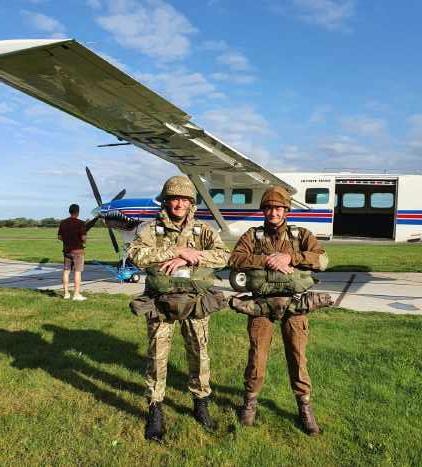
Kevin “Tokalosh” Brown om met die kursus hand by te sit en so paar ekstra spronge ook in te kry. Julle manne ken mos daardie gevoel! Indien enigiemand by ons wil aansluit is hul meer as welkom. As jy meer as ‘n jaar terug gespring het, dan sal jy die volle 5-dag kursus moet doen, maar as dit nie meer as 3 maande gelede is nie
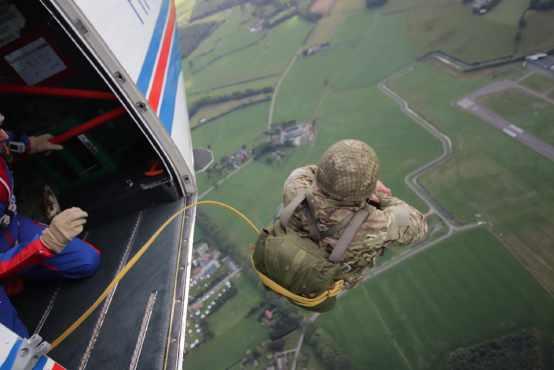
Grant Campbell (oud-SA Cousins (oud-SAW (met ronde militêre valskerm) dan

Net eers ‘n lid word van Pathfinder, en aan die ander vereistes voldoen.

Vir verdere inligting kyk asb. op: http:// www.pathfindergroupuk.com/
Major “Mad Mike” Hoare
Chris Hoare
Hi Hennie Nice to chat as usual, and of course I will look you up when I am in Pretoria. I had a gap, so an article and photo are now attached. Many thanks for your offer to carry this in your next Nongqai, much appreciated. I have put in the link to my website at the bottom, that's the important thing for me. Regards, Chris.

The name ‘Mad Mike’ Hoare is known to most people of a certain age in South Africa and indeed around the world. He was mostly admired for leading 300 ‘Wild Geese’ from 19 different nations across the Congo in 1964 and 1965 to crush a communist rebellion. Of course, most people who had never met Mike thought he was a big bearded thug with daggers sticking out of every pocket and with several ammo belts around his chest. The truth was completely different. Mike was a pukka former British Army major who had become a chartered accountant, and for whom good manners were paramount in life. Mike’s son Chris, in his biography on his ‘mad dad’ entitled ‘Mad Mike’ Hoare: The Legend, describes what a British journalist made of all this in December 1964 as follows: Meanwhile, although 5 Commando had saved the lives of probably 2000 innocent hostages, and had liberated vast areas of the country from Simba control, they continued to attract a bad press. The preconceived notions of Anthony Mockler, who was sent to Leopoldville in the Congo at the end of 1964 as an ‘apprehensive’ special correspondent for The Guardian newspaper, would be typical. As he says in his book: ‘At The Guardian the general view was that mercenaries ... were the dregs of Europe – hired killers. The reason for my apprehension was that my assignment was to
track down the leader of the mercenaries, the hired killer par excellence, “Mad Mike” Hoare. ‘It came therefore as something of an anti-climax when I discovered that “Mad Mike” Hoare was staying in Room 534 of the Hotel Leopold II where I was myself installed. His physical appearance came as an even greater shock. He bore no resemblance at all to a hired killer or a dreg from a gutter. He was short, dapper and very neatly turned out in light khaki with a major’s crown on his epaulettes. He wore a beret but he carried an attaché case, not a weapon. He resembled a British officer from a good regiment, though possibly politer and more courteous than most of that class. He appeared to be in no way insane. ‘That evening he took me out for a drink in a bar on Boulevard 30 Juin. He drank orange juice himself. ... He talked of his crusade against com-
Wes-Kaap" via Peter Greef
Today 119 years ago in the afternoon James Baxter, member of the Smuts/Bouwer commando was shot at Govermentsvlei near Aberdeen. He was placed against the tree to face the firing squad. Stone to be placed there in the near future. Die Vriende van die Oorlogsmuseum se toer na die Middelande in 2019 het ons geneem na die plaas Goewenmentsvley in die Aberdeendistrik. Om daar te staan op die uitgestrekte droë Karoo en al wat oorbly om die uiters tragiese gebeure van 13/10/1901 te gedenk is ‘n taai ou Witgatboom. Die uitgekrapte datum na 120 jaar amper onleesbaar. Ons was almal so met weemoed gevul dat ons besluit het om John Alexander Baxter se lewe te gedenk voor die laaste getuienis verdwyn. munism and told me how in order to instil the regimental spirit he insisted on church parade and football matches every Sunday for the “volunteers” ... of 5 Commando.’ (Mike was often described as dapper, as above, but it was not until 2009 that I was able to confirm that he did not wear standard issue 5 Commando uniforms – he had his uniforms made at Lerwill Pope, probably Durban’s most prestigious firm of tailors at that time. Mike, however, was not at all embarrassed about this revelation, saying it was important for a leader to be smartly turned-out, to look the part, and to differentiate himself from the men.) For more about Mike Hoare, including short videos and blogs, please go to www.madmikehoare.com
Anglo Boer War: John Alexander Baxter
"Friends of the War Museum, Western Cape" | "Vriende van die Oorlogsmuseum,

Mockler’s book is entitled: The New Mercenaries.
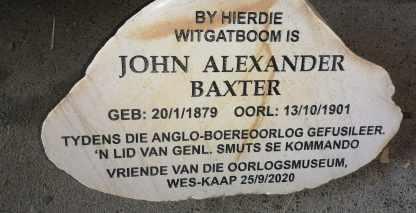
Capt Andre van Ellinckhuyzen (SAPS Vryheid)

not known. A further 34 957 names are inscribed on Monday the 20th of November 1876 at Rouxville in the Orange Free State. His father was
a local school teacher, Douw Gerbrand van der Walt who was born in 1856 in Burgersdorp in the Eastern Cape, and died in 1886 at Tweepan near Rouxville in the Free State. His mother was Alida Hendrina Magrieta Henning who was born in 1857, also at Burgersdorp. Henning had two brothers and three sisters. During the Anglo Boer War, Henning served with the Vryheid Commando, and on 1 August 1901 he was captured by the British near Dundee. On the 2nd of November 1901 he was sent by ship to the British POW camp in Shahjahanpur in the Uttar Pradesh Province in India, where he remained until after the end of the war. The Menin Gate Memorial to the Missing (above), is one of four memorials to the missing in After returning to Vryheid from India, Henning qualified himself as a School Teacher, and before joinFlanders, and it was designed by Sir Reginald ing up at the start of the Great War he taught at a Blomfield, and unveiled in 1927. It is located in the farm school on one of the farms of his friend, Christown of Ypres, Belgium, and dedicated to the many tian Lodewyk Kritzinger, named Donkerhoek, near thousands of British and Commonwealth service- Hlobane. men who were killed there and whose graves are Henning served with the Vryheid Mounted Rifles, unknown. for nine months, as their Regimental Quartermaster, and thereafter with the Union Defence Force during the 1914 rebellion at the start of the Great War, and also during the German South West Africa Campaign, in that same year. On 1 November 1916, Henning joined the South African Expeditionary Force in Pretoria. He was described as being 5 foot 10 in length, weighing 168 lbs, with grey eyes, and brown hair. After receiving military training in The memorial is located on the east side of Ypres Southampton on the 12th of April 1917, and arrived where it marks a road out of the town, in the direc- in Rouen, in France on the 16th of April 1917. At tion of the nearby town of Menin, that was used by the beginning of October 1917, Henning was back Allied soldiers, during WW1, on their walk to the front line, and to an almost certain death. The huge in London England on “furlough”, and it was during that time in London that he got married. At the end of November Henning was again granted furlough stone walls of the Menin Gate are covered with the due to medical reasons. He returned to France at names of 54 896 soldiers (564 South Africans), the start of April 1918, and very soon thereafter who lost their lives in battle and whose graves are fate would take his life. on the walls of the Tyne Cot Cemetery east of Henning married Staff Nurse Hannah Florence Diesel of the S.A.M.N.S., who was from Senekal in the Ypres, as the already massive Menin Gate Memo- Free State. They were married in London, England rial was not nearly big enough for all the names of on the 11th October 1917. Both Henning and Hanthe missing men. From October 1914 to October nah served in France and in Belgium during the 1918 nearly 200 000 servicemen fell at Ypres. Great War, but at the time of their marriage they Henning Willem Jacobus van der Walt, was born dent at number 23 Bessborough Street. England, Henning, for the first time, embarked in were temporarily based in London, and were resi(Continued on page 147) NONGQAI VOL 11 NO 11 NOV 2020 146
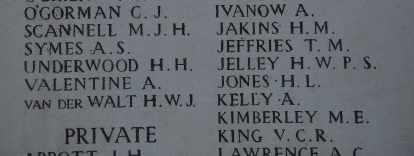
In a letter dated Bloemfontein, 4 October 1918, and addressed to the Master of the Supreme Court in Bloemfontein, Hannah wrote that her husband was a Teacher in a school at Donkerhoek, “Vrijheid” Natal, and that he had resigned his teaching post to join the Forces going overseas, and that they got married in London on 11 October 1917, and that it was their intention to settle in Vryheid once the war was over. Hannah resigned from the military on the 20th of October 1918. Henning van der Walt’s closest friend was Christian Lodewyk Kritzinger from Donkerhoek, near Vryheid. Kritzinger at one time also lived at 95 President Street in Vryheid. This is the same house where Boer General Emmett once lived. Kritzinger was the owner of the farms Umkoesberg, Uitkomst, Vergelegen and Donkerhoek, near Hlobane.
The Silver Chalice that is still in use during Holy Communion at the St Peters Anglican Church
Lance Corporal Henning Willem Jacobus van der Walt of the South African Infantry 2nd Regiment, was 39 years old when he joined up for the war, and he was killed in action on 21 April 1918 at the age of 41 years. His place of death was indicated as Ypres, West-Vlaanderen, Belgium, and he has an unmarked grave. His name is remembered on the Ypres Menin Gate Memorial to the Missing, along with at least two other Vryheid men, namely: Private Maurice Egbert Northern, and Private Wil-


liam John Minott.
Their initials are inscribed on the Chalice
The names of these three men are also inscribed on the War Memorial in Vryheid, and Northern and Minott are honoured on a bronze plaque, and on a silver chalice inside the St. Peters Anglican Church in Vryheid. After the death of her husband, Hannah never married again, and sadly she had no children of her own. She was a career Nursing Sister, and passed away on the 18th of March 1959, at the age of 84 years, in her home in Roselaan, at Bloemspruit, in Bloemfontein. Ever since July 1927, and to this day, a group of buglers, without fail, stand at attention, every day at 8pm, in the Menin Gate, and sound “The Last
Post”.
Lest we forget.
Although it was 70 years ago it still feels like yesterday that my Sister and I sat on the stairs in the house in Wynberg Military Camp and watched my Dad, Leslie Webb, say goodbye to my Mom before leaving for the Cape Town for Durban to begin his journey as a South African Air Force volunteer for duty with 2 Squadron in Korea. The date was 22 September 1950. Departing from Durban on 26 September 1950 on board the Royal Interocean Lines “Tjisadane” my Dad was part of an initial contingent of 50 officers and 157 Other Ranks who had volunteered for service in the Far East. After a journey of 6 weeks the members arrived at Yokohama Harbour and travelled to Johnson Air base just outside Tokyo where they received Conversion Training on the P51 Mustang and general theatre orientation. On 16 November 1950 my Dad was part of an advance SAAF contingent of 13 Officers and 21 other Ranks who travelled to Pusan East (K-9) in Korea. 2 Squadron were stationed at several Air Bases namely Pyongyang East (K-24), Suwon (K-13), Chinhae (K-10). Chinhae was used by the Squadron as a rear base where my Dad spent most of his time in Korea and spent many hours telling me stories of the trials, tribulations, hardships and also good times he spent there. The only ablutions that they had were toilets and showers and to make life easier, especially during the exceptionally cold winters, they halved a Napalm drop tank which the used in the shack they stayed in, as a bath after warming water on a stove. Although the time spent in Korea was mostly difficult with the cold in winter and the heat in summer and the accommodation not always up to scratch, and of course being half a world away from loved ones and your country there was also time for some relaxation and other activities. My dad was part of a 2 Squadron Choir and also enjoyed periodic “R and R” in Japan. There was also a facility where members could record a message for loved ones at home on a vinyl disc which could be played on a record player. I still have the one my Dad sent home although the quality is not so good measured against today’s HD quality. My Dad served in Korea from 26 September 1950 to 5 October 1951 and resultant of his service was awarded the following Medals • United Nations Korea Service Medal • South Korea- Korea Service Medal with TaeGuk Button • South African Korean War Campaign Medal 2 Squadron was also awarded the Presidential Unit Citation which all 2 Squadron Members are entitled to wear as a Decoration.
Following are a selection of photos from my Dads collection:
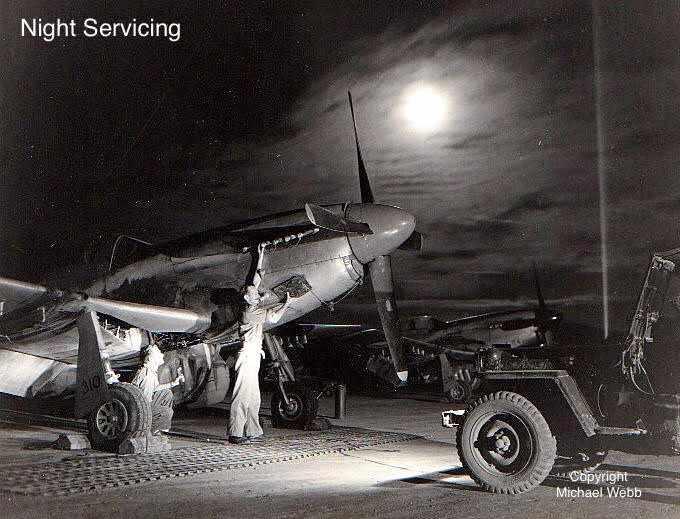
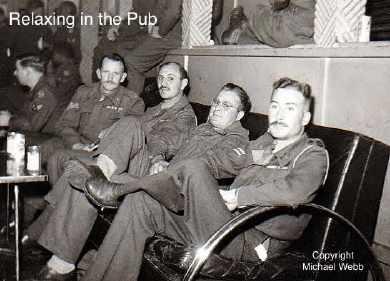













Forgotten Hero! Lieutenant João da Silveira Rodrigues Mitras.



Manuel Resende Ferreira.
Lt João Mitras, was a former Portuguese Army officer in the Engineer Corps who served in the Portuguese African Province of Mozambique. Shortly after the Portuguese leftist revolution, João and his family took refuge in South Africa. Lt Mitras, was one of many Portuguese soldiers who refused to surrender after the shameful handover of the Portuguese Provinces by the MFA (Movimento das Forças Armadas) to Soviet backed terrorist groups. When the call came to form an independent fighting unit under the command of Carlos Ferreira, to help Portuguese families (refugees) reach South West Africa (Namibia), he didn't hesitate and joined Carlos as his second in Command in Southern Angola. They formed a small unit of 11 Warriors, whose main objective was to help refugees reach safety
in SWA. Later it's assumed that they became part of ELP (Exército de Libertação de Portugal). The same soil Lt Mitras had sworned to defend was soaked with his own blood. In mid September 1975, while in command of a small group, João was ambushed by a FAPLA force while moving through Otjinjau. João Mitras and one of his soldiers called Navalhas were killed. Navalhas was also a former Portuguese soldier. Their bodies were recovered and the FAPLA group responsible for their death tracked down. Their commander killed, a small avenge for the loss of two Heroes, who had laid their lives helping their fellow countrymen.
Both were buried in Chitado and the South African Army provided a Guard of Honor. Miguel, João's son who was only 9 years old when his dad died went on to serve with Military Intelligence (DST). João you are no longer forgotten! Your name forever engraved in our hearts!
Manuel Resende Ferreira (Former Staff Sgt)
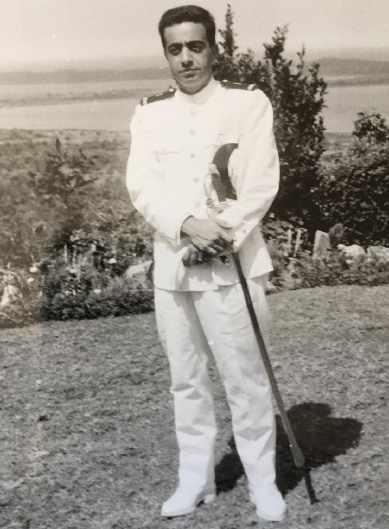


Lest We Forget! Salute!
The Buffel - Part 5 (Final)

The Acquisition Process of the Buffel
The trials at Zeerust had highlighted certain shortcomings in the prototype Buffel and with the help of the Daimler Benz Unimog team we had managed to address most of these. These included fitting rims with greater offset to improve stability, heavier coil springs and an anti-roll bar to reduce the swaying because of the high center of gravity which could not be reduced much without prejudicing the blast protection. The Daimler Benz Unimog team then returned home and we, the UCDD team, returned to Zeerust once more for more durability testing, this time with no other outsiders in attendance. After about 2 weeks of non-stop driving which included a number of small adjustments and mods being made we reached the stage where everything seemed to be going well with no further failures of any significance experienced and we now had confidence that our vehicle was up to the task. Only one challenge remained and quite a big one too. We had no orders and I was only too aware that my partners and ourselves had invested a lot of money in the project and somewhere we had to start getting some of it back. Since Armscor were not interested (and were also already deeply involved with the Samil project) and the Army brass in Pretoria were similarly cool about the project, it was time to think outside of the box. Desperate times call for desperate measures so I made the call to go straight to where the real action was - the "operational area" in northern SWA and to go and do a presentation there to the people at the "sharp end" with the prototype and if that failed, well then it was pretty well game over". I managed to get an appointment with General Jannie Geldenhuys and his team and a short while later the prototype was on its way whilst I flew up to meet with General Geldenhuys. What a gentleman. I was courteously welcomed by the general who also made it clear in a friendly way right at the outset that he could do no more than comment about the vehicle and but it was solely "up to Pretoria" whether they wanted to take it further or not. I understood that.
I was afforded enough time to do a comprehenPhotograph #2 sive presentation to him and his team and apart from the fact that they were quite amused by the radical design (with a fair bit of puzzled headscratching as well) they were for the most part, quite positive about the vehicle. With the presentation over, we met for a short concluding discussion over coffee with the general passing a significant remark - one could not really draw any meaningful conclusions from testing only one vehicle. Ideally 10 should be built which would be a useful sample size in case of problems during trials. He also made it clear that while, he and his team generally liked the concept of my Buffel, he could not get involved in the process going forward and whatever happened in future would be up to Armscor and "Pretoria". My partners and I had already risked so much and now we faced the prospect of probably having to invest even more ....without even an order
or official interest to show! Somewhat dejected I returned to Pretoria and reported back to my boss, Morris Shenker. His advice to me was to take a short break to clear my mind and "get over it" then we could talk again. He believed in the project 100% and was not going to just throw the towel in. My repeated efforts to get Armscor and the SADF interested in the Buffel, frustratingly, produced no results, but I did start getting hints from a few middle ranking officers that perhaps I should seriously consider building nine more prototypes that the army could test. Only problem was there were no funds available for such a development and the decision had also been taken to phase out the Unimog which was to be replaced by vehicles in the Samil range which made the whole project even more risky What readers may not be aware of is that at that time there was actually a full scale "war" going on behind the scenes with the Armscor senior management pushing the "aircooled" Magirus Deutz vehicles (later to become SAMIL trucks) for the new range of SADF vehicles whilst the rest of the South African truck industry and I were in the socalled "watercooled" group and we continued promoting our products with increased vigour to the SADF. The more energetically we promoted our products the more hostile the Armscor "air-cooled brigade" became and this was also major reason why Armscor did not want the Buffel to succeed as it would extend the Unimog's service life, possibly to the detriment of the Samil products and that "war" then became very nasty and personal I know because I went through it from the beginning right through to the end.
But back to the Buffel prototype. A truly horrible decision now faced us - do we draw a line through the project and throw everything away that we believed in (including many thousands of Rands) or do we roll the dice one more time and "go all in" and build nine more prototypes . I got hold of John Davies of Busaf Border and Pat Ball of Transerve and finally managed to convince them to build nine more prototypes, mainly at our expense. Armscor would provide the steel and we would be paid the equivalent of a Unimog dropside body, leaving us with a shortfall of more than R15000-00 per vehicle (excluding development costs).
One of the most difficult decisions of my entire career and one I still often think about after what happened afterwards. There were still a few new Unimogs with dropside bodies to be delivered against what was to have been the last Unimog contract for the SADF and we were allowed to use nine of these for conversion. A few weeks later we delivered the last nine prototype vehicles......... and then came our first nasty shock! Armscor advised me that my development team and I were FORMALLY BANNED FROM ANY FURTHER INVOLVEMENT WITH THE PROTOTYPE VEHICLES with immediate effect! Unbelievable as it may sound, that is then truth. When I fiercely objected to this, wait for it............I was advised that this was now also a CLASSIFIED project (I had created it and now it was apparently CLASSIFIED and I was barred from participating in the official trials of a vehicle my partners and I had designed and developed? Insane!!) and furthermore, in terms of the "Official Secrets Act", steps would be taken against me if I tried to get involved with the project in any way or made a noise about the way I was being treated !!! Simply put - I was threatened by Armscor management to shut up or face the consequences............and I knew how low they could stoop. What I learnt from my sources some time later was that Armscor and the SADF (with CSIR support at the Army's request) were conducting trials in the then Northern Transvaal and also Northern SWA and that was where the myth actually started that Dr Joynt and Kobus Joubert of Armscor were the original creators of the Buffel because they were the only people the soldiers and SADF officers saw and met during the whole evaluation and trials process. Another fact for the record. During all the time that the prototypes were being tested not one person
from our team was invited to the many events and presentations arranged around the many army bases so most people concluded that Dr Joynt and Kobus Joubert were the people behind this vehicle. This blatant lie (which they certainly did not make any effort to correct) has continued to this day and it has created most of the confusion around the origin of the Buffel project that continues still today. Not only were they happy to bask in the glory (by default through our absence from the trials) for the work we had done, but soon stories were put out that we had built an overweight vehicle which they had to lighten and modify etc etc.. That was rich considering amongst other things, we had fitted the very heavy belly plate that Dr Joynt had insisted upon which they removed (that alone was around 80kg as I recall) and was included in the "weight they had removed". Furthermore, we had also not been given access to our prototypes or the opportunity to reduce the weight nor did we even have a specification to work to! It needs to be remembered that we created this vehicle from scratch with no official specification, nor any help or input from either the SADF or Armscor as to what was required and what was not needed - zilch, zero, nada, nothing ......... Ironically, whilst we were banned and barred from the trials, as soon as there was a problem they would come knocking on my door for assistance. A good example. When the tubular crossmembers started cracking where they were welded into the main chassis rails, they did not know how to fix it and came to me for urgent assistance. With the help of my friends in the Unimog Design Department at Gaggenau (who by that time were already thoroughly "gatvol" of Armscor) we nevertheless came up with a solution within days and supplied the dished and shaped steel discs ( we called them "tulips") that were welded in on the crossmember ends to reinforce those areas and were then fitted to every Buffel afterwards. All the while (which was most of 1977) we were kept completely in the dark about what was happening with the 10 prototype vehicles we had supplied whilst the Armscor/CSIR Buffel team visited numerous bases and army units telling with these
vehicles and so the story gained more momentum that they were the creators of these vehicles. In the latter part of 1997 I was contacted to provide Armscor with a price for producing a quantity of Buffel vehicles and told a mine-blast test was going to be conducted on one of the prototype vehicles.........and I would be allowed as a "special favour" to attend the blast test. Wow, how generous ................ Together with Busaf Border and Transerve Pty Ltd we prepared an offer and submitted it to Armscor ...and then silence................. The day of the mine-blast test arrived and an enormous baboon (suitably drugged) was strapped in in the drivers cab and we all took shelter in the concrete structure about 200m away. The blast was a powerful one with pieces of rim, tyre and chassis parts flying all over the place and after the dust had settled and the blast site had been declared safe, we were allowed to go and look. The baboon was still safely strapped in with no injuries other than a cut lip where a small piece of the weld from the mudguard support bracket had broken loose from the shock and had cut his lip. He certainly was not a happy chappy when he was taken out. Dr Joynt declared the test a success and I was of course delighted because I now could see no reason why the SADF could not accept this vehicle into service when the mine threat was escalating dramatically in the operational area by the day and the SADF had no suitable vehicles available. Interestingly, it was at this blast test that I remarked to an SADF officer that there was no longer any good reason why the SADF could not soon be operating these vehicles. He then responded by saying that if it were indeed adopted by the SADF it would also be called Buffel and that was the first time I had heard that name mentioned. Note : Whilst I have been referring to the prototypes as Bosvark 2 or Buffel prototypes, as I have done on this site, they were actually Bosvark 2 prototypes (I coined the name Bosvark 2 as it was not an official project and there was no official name for it at the time). I used the term Buffel prototypes deliberately in the last chapters of this (Continued on page 156) NONGQAI VOL 11 NO 11 NOV 2020 155
short history to avoid confusion with the Bosvark developed by CSIR because there was no connection at all and in essence they were the first Buffels. The other interesting thing I remember from the day of the blast test was that the senior Armscor Manager (part of the "aircooled group") who attended the blast was clearly not happy with the result because I suspect he feared it could delay the final phasing out of the Unimog/introduction of the Samil vehicles. In spite of the successful blast test nothing further happened in 1977 (and we were still barred from seeing what was being done with our vehicles). We learnt afterwards that more trials were done (which continued into early 1978) after the blast with more modifications being introduced along the way. Then out of the blue we were suddenly asked to urgently submit an offer for 288 Buffel conversions to be urgently supplied. I personally prepared the offer and handed it to Mr Naas van der Walt of Armscor who came to my office to collect it. I then contacted Messrs Busaf Border Pty Ltd and Transerve Pty Ltd to start preparing for production because of the urgency of the requirement and an undertaking from Armscor that we would get an answer "within days". Interestingly, whilst Mr Van der Walt was still in my office, he was called by his manager on my office phone (the days before cellphones) to inquire whether he had obtained our offer and then to return to the office immediately. Something did not sound right to me........ And then silence. Not a word out of Armscor other than a request that I must check that Daimler Benz Unimog Division were ready to supply 288 new stripped (minus cab) Unimog 416.162 chassis for the project ASAP. What followed next I refer to as the "Buffel Bombshell". Mr Van der Walt called me to advise me that UCDD were going to be awarded a contract for the supply of 288 stripped chassis, but the Buffel conversions would be done by another company which he could not disclose. Also, we could expect a formal letter later. Only later we learnt it was Steelmobile that were given the contract and still later we also learnt that soon after my providing our offer, Steelmobile had that information.
All hell now broke loose and an urgent meeting was convened with Messrs Busaf Border Pty Ltd and Transerve Pty Ltd to discuss this development. Daimler Benz were of course also advised and they were very understandably angry. My boss, Mr Morris Shenker was fired up and ready to take legal action against Armscor but our Chairman, Dr Hurter of Volkskas (which owned 25% of the UCDD shares) asked him to hold off until we had had an opportunity to discuss the matter with Armscor senior management . A meeting was duly set up with Armscor senior management and our UCDD team consisted of Dr Hurter, Mr Shenker, Mr Hein te Poel and myself. It was a very tense and heated meeting from the word go as Armscor tried to tell us that a better "value for money offer" had been submitted by Steelmobile who were supposedly also better equipped and more experienced in manufacturing truck bodies (for the record, they were a pressing plant) etc etc . BS by the bucketful and we were expected to just calmly sit and believe all this nonsense! Yet, no comment from the Armscor management when we challenged their statement that Steelmobile could offer lower prices because they had incurred no development costs which we needed to amortize nor how our IP could just be taken by Armscor without compensation. Armscor's view was simply that they were free to use our IP (without compensation) if they deemed it in the national interest and that was that.
It is worth noting though that Nissan was the owner of Steelmobile and Truckmakers was a subsidiary of Nissan as well at the time. Purely an amazing coincidence? Join the dots and see where it leads ............. After this fateful meeting in 1978 the water was well and truly permanently poisoned between Armscor and UCDD (and me in particular) because we had dared to challenge the mighty Armscor and their unethical behaviour. Undeterred, I still tried again a few more times to
at least get some of the Buffel work for Messrs Busaf Border Pty Ltd and Transerve Pty Ltd, but without success. It was heartbreaking how unfairly they had been treated. To be honest, I was gutted. I do not do business like this and felt personally responsible for letting my development partners (and friends) down even though I was powerless to do anything about it and gentlemen that they were, they did not hold it against me because they knew very well what we were up against. In the end they just walked away from it all and wrote off their investment in the project. Lesson learnt, never to trust Armscor ever again. Busaf Border Pty Ltd closed its doors not long after this as did Transerve Pty Ltd. We went on to deliver the 288 Unimog chassis and so essentially ended the Buffel development story up to its introduction into service with the SADF. For me personally this was also a watershed moment because I witnessed firsthand, the unacceptable and unethical behaviour by Armscor who acted like they were a law unto themselves and firmly believed they could do as they liked without fear of any action being taken against them because the Minister "had their backs" and the "Wetgewing" protected them as I was so frequently reminded. Why I refer to their behaviour as unethical and unacceptable: 1. Messrs Busaf Border Pty Ltd were our development partner for the Buffel as I clearly described in this story. Armscor were very much aware of that yet contracted Steelmobile who had not invested one cent in the development of this vehicle and so could offer a slightly cheaper price. Why was there at the very least, no compensation for Busaf Border Pty Ltd who took the risk and invested so much of their own money? 2. Messrs Transerve Pty Ltd was my other development partner for the Buffel. Armscor were also very much aware of that yet contracted Steelmobile who had not invested one cent in the development of this vehicle and so could offer a cheaper price. Where is the compensation for Transerve Pty Ltd who took the risk and spent their own money?
3. The IP for what became the Buffel in the SADF belonged to UCDD and my development partners and no attempt was made by Armscor to compensate us for the use of our IP. Their argument seemed to be that because they had managed and conducted the trials and done mods along the way (it was no less than "project hijacking" because we were deliberately kept out of and away from the project) and had made changes along the way it was no longer the vehicle exactly as we had designed it so it suddenly became Armscor's and CSIR's IP. Lawyers in a normal society would have had a field day with this, but we are talking about South Africa in 1978. 4. After the disgraceful Buffel saga, Armscor were very annoyed about the waves we had made about their awarding the business to Steelmobile and had their knives in for us. An example. They then went out of their way to buy Unimog parts from third parties (and "smouse") including some really shady characters, rather than from UCDD and this cost taxpayers. Just one example. There was a requirement for 40 Unimog gearboxes (for Unimog 416.162) which they asked a trader in Hamburg to supply. Problem was the Unimog 416.162 used a special gearbox which was not freely available and my Unimog friends tipped me off that an "agent" in Hamburg was scrounging around for 40 gearboxes for South Africa and they knew it was for the SADF. This guy could of course not obtain the correct transmissions so supplied what he could get which also had to be paid for before they left Germany. I can clearly remember the panic when these wrong gearboxes arrived in South Africa and who knows what happened to those 40 gearboxes eventually or how this was hushed up. We supplied the correct gearboxes afterwards. 5. The special offset rims used on the Buffel were originally provided by Messrs Lemmerz in Germany who specially designed and manufactured them for us. They were subsequently just copied and produced in South Africa without permission or licence.
All of this happened up until 1978 when the Buffel went into service with the SADF.
An interesting story to conclude the Buffel history up to production with. In early 1986 I was contacted by the late Peter Stiff who told me that he had been granted official permission to write a book about mine protection and the development of mine protected vehicles and he wanted to talk to me about the Buffel because someone had mentioned to him in passing that I may have had something to do with the Buffel and I may also have some photographs, but his source(s) were not really sure. Peter met me in my office and hours later, after I had shown him my photographs and my copious notes on the Buffel development, he switched off his recorder and let out a loud expletive. He simply could not believe what I had shared with him. Up, to that point he had had no idea of our involvement as all his "sources" up to that point had mostly focused on Armscor and CSIR's involvement with the creation of the Buffel.

He then asked me to put my account of the Buffel's development, right from the beginning, in writing (because there was so much detail) and asked my permission to use some of my photographs because mysteriously enough, none of the Buffel "designers/creators " to whom he had spoken were able to fill in the blanks about the early days of the project or could provide photographs of the early development. Wonder why they did not have that information and photographs if they did the development.? As requested, I provided him with the complete history in much the same factual form as I have done here together with a selection of photographs (many of which he used in his book, "Taming the Landmine") and left him to get on with his other interviews because he was still going to talk to others about the project as well and also test my facts against their versions/stories. About a month later he paid me a visit again to return my photographs and apologetically told me that he reluctantly had had to make changes to the Buffel story because of "sensitivities" around
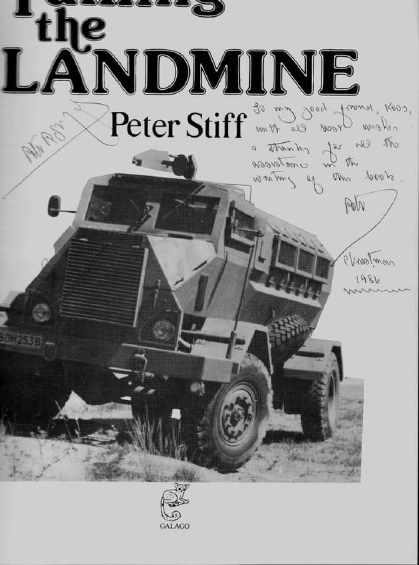
certain people such as where I had mentioned the
lack of interest and support by the SADF top brass at the time, Armscor's banning us from the trials and their unethical behaviour when placing the contract with Steelmobile - that did not reflect well on them (no doubt as it undermined the official propaganda that had been put out) and they were very concerned about what the public would think after reading his book. Furthermore, he had had to embellish the CSIR's contribution a bit because the impression had been widely promoted that the CSIR and Dr Joynt (whose name he was apparently not allowed to mention in the book) were really the developers of the Buffel and the public could draw the conclusion that misinformation had been put out if he published the strictly factual truth. Being a man of high integrity he was not happy at being forced to make the changes, but he did make some minor changes which did not fundamentally change the overall history so that publication of his book could at least proceed. When he delivered my signed copy of "Taming the Landmine" just before Christmas 1986 (see attached photograph), he shared with me his revealing and sobering experience with the Chairman of Armscor. He had just published "Taming the Landmine" and had made an appointment to meet with Commandant Piet Marais, the Chairman of Armscor to hand over a leatherbound copy of the book to him (and no doubt also try and enlist Armscor's assistance to promote the book). The meeting went badly. The Commandant was most unhappy because Armscor's involvement with the Buffel showed Armscor up in a very poor light, my name (and my partners) appeared too frequently in the Buffel story and Armscor and CSIR who had really done the work (as far as he was concerned) were not given the due credit they deserved - they had done by far the most of the work and the book did not reflect that so he could not accept the book.

Peter courteously took his leave and that was the end of the matter - he would not change his book to suit the misinformation narrative and chose to stick to his guns. His account of the Buffel project can be found on pages 104 o 110 of "Taming the Landmine" and for easy reference I attach copies of the parts dealing with the nine extra prototypes we delivered through to contract award to Steelmobile - a permanent reminder of the unethical behaviour of
Senior Management of Armscor at that time. Peter, I salute you for having had the courage to stick to your guns and not to sacrifice the truth. Koos de Wet
March 21, 2017
Sex, Consent, Stealthing & Fraud Mail on Line

French ambassador is investigated for 'stealthing' after woman he had consensual sex with realised 'during the act' that he was not wearing a condom
• A woman, 30, says she went back with the ambassador, 44, after meeting online • She asked him to use a condom during sex but was unaware he hadn't put one on • She realised during the act and filed a complaint with police three days later • Stealthing is considered a form of rape but in some countries the law is unclear By Jack Newman for Mailonline and AFP Published: 16:12 BST, 29 September 2020 | Updated: 17:53 BST, 29 September 2020 A French ambassador who allegedly had sex with a woman who didn't realise he wasn't wearing a condom is being investigated by Paris prosecutors. The woman, 30, claims she is a victim of 'stealthing' after telling police she had spent part of the night at the home of the ambassador, 44, she had met through a dating site. A source close to the inquiry said: 'They had met up several times without any sexual relations. That evening, they had consensual sex.'
A French ambassador who had sex with a woman who didn't realise he wasn't wearing a condom is being investigated by Paris prosecutors (file image)
Confirming the report in French magazine Le Point, the source added: 'She asked him to use a condom but realised during the act that the man was not wearing one.' The woman filed her complaint three days later. The source did not identify him by name, while Le Point said only that he is based in the Middle East. French law defines rape as 'any sexual penetra-

tion... committed against another through violence, force, threat or surprise'. But no clear jurisprudence exists for 'stealthing', which is when a man removes a condom while having sex with a partner who requested he wear

one.
No clear jurisprudence exists in France for 'stealthing', which is when a man removes a condom while having sex with a partner who requested he wear one
The action can potentially expose him or her to HIV or other sexually transmitted diseases. A woman also risks being impregnated. In January 2017, a court in Lausanne, Switzerland, handed a Frenchman a suspended 12month prison sentence after convicting him of 'rape' for removing his condom without telling his partner. A few months later, the sentence was upheld on appeal, but the court lowered the charge to 'a sexual act committed against a person unable to discern or resist it'. A scene depicting stealthing was shown recently in Michaela Coel's hit BBC sitcom I May Destroy You, in which the man is labelled a rapist. Share or comment on this article: French ambassador investigated after woman 'realised during the act he was not wearing a condom' https://www.dailymail.co.uk/news/article-8785705/ French-ambassador-investigated-woman-realised -act-not-wearing-condom.html
Suid-Afrikaanse regsmenings Dr (adv) Len Els, SC

man egter wetend HIV-positief is, kan dit wel poging tot moord daarstel. Sivielregterlik ‘n ope vraag. Die vrou sal skade en die quantum daarvan moet bewys. Was daar ‘n glips, staan die onderhoudshof se deur wawyd oop! Gegroet

My vriend die landdros (naam weerhou) skryf soos volg: “Hallo Hennie, hier is die opinie van die advokaat van wie ek jou vertel het. Ek dink dit se omtrent alles wat daaroor gesê kan word. Dis natuurlik ook vanselfsprekend dat die tipe verhouding tussen die twee mense ook van deurslaggewende belang sal wees mbt ‘n beoordeling van so ‘n klagte, dws die duur daarvan en die mate van intimiteit wat daar al voorheen plaasgevind het ens. Dis maar so in die reg dat elke situasie op sy eie meriete beoordeel moet word. Groete.”
Wat is jou mening rakende moontlike vervolging in SA met ‘n feitestel soos hierby aangeheg? Bedrog word blykbaar gepleeg om toestemming tot ‘beskermende’ seksuele penetrasie te bekom. Wat ek sien in ons wetgewing (wet 32 van 2007) wat o.a. van toepassing kan wees, is: (3) Circumstances in subsection (2) in respect of which a person ('B') (the complainant) does not voluntarily or without coercion agree to an act of sexual penetration, as contemplated in sections 3 and 4, or an act of sexual violation as contemplated in sections 5 (1), 6 and 7 or any other act as contemplated in sections 8 (1), 8 (2), 8 (3), 9, 10, 12, 17 (1), 17 (2), 17 (3) (a), 19, 20 (1), 21 (1), 21 (2), 21 (3) and 22 include, but are not limited to, the following: (c) where the sexual act is committed under false pretences or by fraudulent means, including where B is led to believe by A thatDis ‘n tricky ene! Sover my kennis strek, maak ons wetgewing nie voorsiening vir ‘conditional consent’ nie. Dit sal tog tot absurditeite lei. As n persoon bv. toestem tot seks, want hulle is verloof met die onderneming om te trou, maar 3 jaar down the line verander een van opinie, en die voorwaarde waarop toestemming gegee is, het nie plaasgevind nie - beteken dit dan nou een van hulle is vir 3 jaar lank verkrag? Dit is ‘n bietjie onregverdig met ‘n kondoom want die gevolge kan verreikend wees, soos swangerskap. As jy iemand onder hierdie omstandighede met HIV of STI besmet, kan daar ander remedies wees soos bv. assault GBH? As een party HiV+ is, en dit verswyg het, kan dit selfs lei to n aanklag van poging tot moord. Die definisie van ‘without consent’ in Wet 32 of 2007 (SORMA), maak volgens my nie voorsiening vir ‘stealthing’ nie.
As ek reg onthou het die Sweedse reg sulke wetgewing en Julian Assange se sogenaamde ‘verkragting’ saak was in terme van daardie wet. Soos in baie omstandighede sal so n geval seker eers duidelikheid kry in SA, wanneer daar ‘n toets saak is, en wanneer ‘n aanklaer die guts het om so ‘n saak op verhoor te neem? Ek hoop dit help? Groete.


The Royal HAIR Force: RAF will allow dreadlocks, braids and ponytails in bid to boost diversity in the service
The Royal Air Force are allowing its airmen to keep dreadlocks, braids and ponytails in a bid to boost diversity in the service. From now on the fashion-conscious can also keep cornrows and twists. Click on: https://www.dailymail.co.uk/news/

Intelligence In Public Media: Russians Among Us: Sleeper Cells, Ghost Stories and the Hunt for Putin’s Agents
Gordon Corera. (William Collins, 2020) 438, notes, index.
Reviewed by JE Leonardson

With Russian intelligence and espionage in the news so much these days, general audiences and specialists alike could use a good primer on Moscow’s operations. Fortunately, British journalist Gordon Corera’s new book, Russians Among Us, provides just such a survey. Corera ’s theme is that Russian President Vladimir Putin, driven by what he views as Russia’s humiliation in the 1990s, has an insatiable hunger to strike back at the United States and the West. Just as powerful, Corera further notes, is that Putin is determined to rebuild Moscow’s global power. For Putin, having strong intelligence capabilities are a critical part of this project, and he therefore has worked relentlessly for 20 years to rebuild, modernize, and weaponize the Russian services. With this in mind, Corera begins by focusing on Ghost Stories, the case of the 10 US-based SVR illegals who were arrested in 2010 and swapped for four prisoners in Russia. He provides an up-todate description of how the SVR’s Directorate S, the home of the illegals, works and how illegals train and operate. He then uses this to document the threats they pose to the security of their target states. The “natural progression of an illegal’s career,” he points out, is to spend “years building their cover and working their way into influential circles.” (230). Donald Heathfield and Cynthia Murphy worked to do exactly that by completing degree programs at Harvard and Columbia Universities, respectively, and then finding jobs in Cambridge and New York that enabled them to mix with academics, think-tankers, and political types to spot and assess potential recruits. Corera ’s description of the case and the investigations relies almost entirely on publicly available sources and, while his account is well researched and generally accurate, one suspects that in spots it would have benefitted from access to the full records of Ghost Stories, which are likely to remain under wraps for decades. Until
then, Russians Among Us will stand as the standard open-source account of the case. His analysis of the illegals’ movements and efforts, too, is a useful corrective to the view that the Ghost Stories illegals were outmoded and hapless. In his last 100 pages, Corera moves beyond Ghost Stories to discuss the evolution of Russian espionage since 2010. As effective as illegals have been for a century, he notes that the SVR is moving away from a traditional model of such operations because the laborious process of creating and backstopping their false biographies now is easily undone by instant searches of digital records and other large data sets. Corera cites several recent US cases to show how Moscow has refined a new method for illegals—first used experimentally in Ghost Stories— that uses large numbers of amateurs, who are given cursory training and then sent to the West in their true identities to collect information as well as to infiltrate and influence political processes; at the same time, he points out that Moscow is undertaking enormous cyber operations to steal information and wreak political havoc. As if that’s not enough, Putin has also authorized the services to undertake assassinations, including operations using chemical weapons, regardless of the consequences for innocent bystanders. Given Putin’s goals, Corera warns, none of this is going away anytime soon. In providing a clear explanation of how Russian intelligence operations are evolving and placing them in geopolitical context, Corera has given us a timely and well-written wake-up call. Highly recommended.
* * * * *
The reviewer: J. E. Leonardson is the penname of an analyst in CIA’s Directorate of Analysis. https://www.cia.gov/library/center-for-the-study-ofintelligence/csi-publications/csi-studies/studies/vol -64-no-2/russians-among-us.html?s=08
Thanks RS 167
Why the U.S. Sent Librarians Undercover to Gather Intelligence During World War II
No one had a well-defined plan to send microfilm specialists to war when Franklin Roosevelt agreed to established the Interdepartmental Committee for the Acquisition of Foreign Publications (IDC). The agency initially struggled to gain traction. Yet over the course of the war, the IDC developed an extensive operation to provide printed sources for intelligence purposes. As bookmen and women became intelligence agents, the ordinary activities of librarianship - acquisition, cataloguing, and reproduction - became fraught with mystery, uncertainty, and even danger. By late spring 1942, plans were set in motion to send microfilm men - and one woman - to Stockholm, Lisbon, and other neutral cities. For those in the intelligence business, wartime Lisbon was an exhilarating place to be. Dictator António de Oliveira Salazar had declared Portugal’s neutrality, hoping to avoid invasion and keep what was left of its shrunken empire. Sympathetic to fascism but bound by a long-standing treaty with Great Britain, he tacked between the Allies and the Axis. Portugal’s neutrality made it the crossroads of Europe and the Americas, a magnet for exiles, diplomats, foreign correspondents, and adventurers. Refugees from occupied countries crowded into Lisbon, enduring long waits for exit visas to England or the Western hemisphere. Cafés, newsstands, and bookstores bustled with newcomers; extravagant parties, dancing salons, and casinos beckoned the wealthy nightly. Not by chance had the city become the travel destination of spies. As one intelligence agent put it, “Lisbon is something like New York on a miniature scale with many visiting firemen passing through every few days.” The classic possibilities of urban modernity - anonymity, disguise, the refashioning of identity - were all heightened in wartime Lisbon. Business cards of oil magnates, movie moguls, and consular attachés concealed clandestine lives. Even book buyers might be intelligence agents. Lisbon had developed its own information economy—an underground market where gossip was traded and rumour bid up. German, British, American and Japanese agents mingled, listening for intelligence and spreading disinformation. Hearsay was already common currency in a place where press censorship and the secret police prevailed, and the war in Europe stoked the rumour mills. The US Office of Strategic Services (OSS) even sent a memo to its station head in Lisbon about rumourmongering, in the upbeat tones of a marketing expert: “In case you have never dabbled in it, the ideal way to spread a rumour is not to tell it in as many places as possible, but to put it in the bonnet of one person whom you know to be a gossip.” Agents could also make up their own rumours, as wild as they pleased, except for three forbidden subjects - future military plans, the activities of neutral countries, and the Pope.

In this world, Americans were innocents abroad, inexperienced at gathering information and assessing its plausibility and utility, outmatched by the veteran British and German clandestine operations. The first OSS agents lacked training, had no background in military or political affairs, and spoke no Portuguese. In early 1942, one admitted, “No one here, I believe, can help but feel that we are ‘behind the eigths ball".
Related Stories
Into the hothouse of Lisbon came those in search
of a different kind of information, in the form of the printed word. Salazar’s heavy hand did not prevent a brisk business in books, newspapers, and magazines among the polyglot population of the city. Newsstands hawked everything from the Daily Express to Das Reich, papers from “every major country in Europe except Russia.” The city had many booksellers, from the venerable Livraria Bertrand, dating to the 18th century, to the newly opened Livraria Portugal, whose owners were sympathetic to the Allied cause. Even stationery stores carried useful works: the Papelaria Fernandes specialized in military subjects, while the Papelaria Pimentel & Casquilho sold engineering books and instruments. Although hamstrung by the censors, customs restrictions and the shifting political winds, these dealers found ways to import publications and keep their shelves stocked. Lisbon hungered for books and news, and educated Portuguese and travellers alike haunted these places. Among them were American librarians working for the IDC. They presented themselves to the Portuguese as American officials collecting materials for the Library of Congress and other governmental libraries, “which are naturally interested in preserving the records of the present crisis in our civilization.” They openly made the rounds of bookstores and stationery shops and placed subscriptions with news dealers. Sympathetic locals, including scholars, publishers, journalists and diplomats, also helped, ordering books and newspapers in their own names, as a front for the Americans. The Portuguese did not request money but desired current books and American magazines like LIFE and TIME. The IDC men would have agreed with an American secret agent who commented, “Some of my most valuable acquaintances in Lisbon have been due to my ability to furnish them with written material otherwise unavailable because of Portuguese censorship.” By 1943 the operation was in full gear. “The publications are rolling in,” Ralph Carruthers, an IDC agent in Lisbon, exulted. “We no sooner begin to see daylight when something else comes along.” The sources and flow of publications varied with the war’s movements. When the Germans tightened border controls and sources in Switzerland began to shut down, the IDC quickly arranged for a large shipment from a Swiss bookseller to a decoy commercial address in Lisbon. The growing French and Italian resistance spurred the collection of underground publications. The IDC outpost tried to fill urgent requests from Washington war agencies, local embassy staff and agents outside
Lisbon. IDC head Frederick G. Kilgour wired for Hungarian newspapers, railroad directories and pre-war Baedekers to aid in military planning. One cable stressed the “great demand for about 250 original daily newspaper issues including duplicates to be obtained with utmost speed.” During Operation Torch, the Allied invasion of North Africa, the OSS outpost in Algiers called on Carruthers to send current German newspapers. “It is not likely that we will get them all,” he reported, “we will be lucky if we get four out of the lot.” In fact, he managed to obtain ten papers by a circuitous route through Tangier that took four days. What was the value of these acquisitions? In the shadow world of intelligence, the printed word was clarifying, or so it seemed. The materiality of publications made them measurable - number of books shipped and microfilm reels shot. Scientific periodicals, technical manuals and industrial directories directly from Axis and occupied countries were studied closely for evidence of enemy troop strength, new weaponry, and economic production. Even trivial items could prove meaningful: society pages might reveal the location of a regiment, and gossip columns “provide clues to scandals which a secret agent could exploit.” The disposition among the well-educated to favour printed over spoken words made such sources seem more reliable. In Lisbon, with its rich diet of rumour and speculation, OSS chief H. Gregory Thomas relished the Legation’s press digests and observed, “many leads I find can be derived here from the local press which I of course read daily.” Even the clandestine Secret Intelligence Branch, which sought human informants, found that “intelligence material from the foreign newspapers is of great value.” War agencies in Washington also considered these materials useful. But there was more to this perception than the simple act of reading texts. The librarians of the IDC transformed the familiar forms of books and serials into the genre of intelligence. Sources:
Wikepedia: Adapted from Information Hunters: When Librarians, Soldiers, and Spies Banded Together in World War II Europe by Kathy Peiss with permission from Oxford University Press, Inc. Copyright © 2020 by Oxford University Press.
(Saamgestel deur Philip Malherbe)
Coordination of Information https://www.google.co.za/search? hl=en&tbm=isch&sxsrf=ALeKk01O6eZDEyZySRO 1euIJ8U6fFL6UsA% 3A1595005392691&source=hp&biw=2049&bih=9 52&ei=0NkRX9PZJpKJlwSz7ZnYDw&q=agents+o f+Office+of+Strategic+Strategy%29&oq=5 Office of Strategic Services – (OSS) https://www.google.co.za/search? hl=en&tbm=isch&sxsrf=ALeKk01O6eZDEyZySRO 1euIJ8U6fFL6UsA% 3A1595005392691&source=hp&biw=2049&bih=9 52&ei=0NkRX9PZJpKJlwSz7ZnYDw&q=agents+o f+Office+of+Strategic+Strategy%29&oq=5 https://www.google.co.za/search? hl=en&tbm=isch&sxsrf=ALeKk01O6eZDEyZySRO 1euIJ8U6fFL6UsA% 3A1595005392691&source=hp&biw=2049&bih=9 52&ei=0NkRX9PZJpKJlwSz7ZnYDw&q=agents+o


f+Office+of+Strategic+Strategy%29&oq=5 Maj gen William “Wild Bill” Donavon – Hoof van OSS (Credit: CORBIS/Corbis/Getty Images)
Voor 1940, het die Verenigde State van Amerika (VSA) se “State Departement”, die “Federal Bureau of Investigastion” (FBI) asook die verskillende militêre takke, almal hul eie veiligheid en teen-spioenasie operasies bedryf, hulle het egter nie maklik inligting met mekaar gedeel nie. Met die dreigende 2de wêreldoorlog in Europa, het president Roosevelt daarop aangedring dat hy beter koördinasie wou hê met betrekking tot die insameling en uitvoering van inligting. Daarom het hy in Julie 1941, vir kolonel William J. Donovan, bekend as “Wild Bill” aangestel as die hoof van “Coordinator of Information (COI). Donovan, het in die 1ste Wêreld Oorlog gedien, as ʼn bataljon bevelvoerder en hy was een van die mees dekoreerde oorlogshelde. Met die aanvang van die grondwerk het hy die COI gedeeltelik gebaseer op Britse Geheime Intelligensiediens (M16). Al die ander VSA agentskappe, insluitende Edgar Hoover van die FBI en Militêre Intelligensie Afdeling was baie skepties, vyandig en
agterdogtig. Na die Japan se aanval op Pearl Harbour, het Roosevelt daadwerklik begin om die VSA se intelligensie vermoë uit te brei, In 1942 het hy die COI vervang met die Office of Strategic Services – OSS. Dit is saamgestel deur die gesamentlike stafhoofde om spioenasie bedrywighede te koördineer, agter die vyandelike linies vir die verdedigingsmagte van die VSA. Ander OSS bedrywighede het ook ingesluit die gebruik van propaganda, ondermynende bedrywighede en voor-oorlogse beplanning. Op 14 Desember 2016, het die organisasie ʼn gesamentlike goue ereKongres Medalje ontvang. Die OSS het oor ʼn uitstekende wêreldwye inligtingsnetwerk, rakende Duitsland se bedrywighede en hul sterk en swak punte beskik. Tydens direkte operasies was hulle heel suksesvol in die ondersteuning van “Operation Torch” in Frans-Noord-Afrika in 1942, waar hul pro -Alliansie ondersteuners en landings plekke kon identifiseer. OSS operasies in neutrale lande, veral in Swede en Switserland, het in-diepte inligting verskaf oor Duitsland se gevorderde tegnologie. In Switserland kon hulle uitgebreide inligting verskaf rakende die Duitse magte se getalle, lugverdediging, duikboot produksie, en die V-1 en V-2 wapens. Die inligting het onder andere geheime bevat ten opsigte van chemiese en biologiese oorlogvoering. Vanaf hul kantoor in Switserland was hul in staat om die Franse en Italianers weerstandsvegters te ondersteun, en was behulpsaam met die oorgawe van die Duitse troepe in Italië in 1945. Noord Afrika https://www.google.co.za/search? hl=en&tbm=isch&sxsrf=ALeKk01O6eZDEyZySRO 1euIJ8U6fFL6UsA% 3A1595005392691&source=hp&biw=2049&bih=9 52&ei=0NkRX9PZJpKJlwSz7ZnYDw&q=agents+o f+Office+of+Strategic+Strategy%29&oq=5 Gedurende die 2de Wêreldoorlog, het die OSS verskeie aktiwiteite en take uitgevoer, insluitende die inwin van inligting deur spioenasie, sabotasie, verspreiding van propaganda, organisering en koördinasie van teen die Nazi’s se weerstand groepe in Europa en die verskaffing van militêre opleiding aan teen-Japannese guerrilla groeperinge in Asië. Op sy hoogtepunt het die OSS ongeveer 13,000 persone in diens gehad. Die OSS het daarin geslaag om Russiese kodes en hul kriptomasjien te ontsyfer, waarna hulle agter gekom dat die Russe in Noord-Amerika spioeneer. Een van die OSS se belangrikste spioene was die Duitse diplomaat Fritz Kolbe.
Fritz Kolbe, Duitse diplomaat en spioen no RG 226.
https://www.archives.gov/publications/ prologue/2002/spring/fritz-kolbe-1.html" Kolbe het wye toegang gehad tot geheime lêers
Operasie Torch (Operation Torch) - die Inval in
en was die beste spioen op die OSS se lys. Kolbe se hanteerder was Allen Dulles, ʼn meester spioen, wat dan ook later aangestel is as hoof van Central Intelligence Agency (CIA). Kolbe was hardwerkend en het die vertroue van sy hoofde geniet. Hy het dan ook toegang tot die mees belangrikste militêre en intelligensie lêers gehad –naamlik magspeile en hul ontplooiing, voorrade roetes, diplomatieke beplanning en spioenasie operasies. Vermelde inligting het hy met sy hanteerder in Switserland gedeel. Gedurende 1943 was die OSS in kontak met die Oostenrykse weerstandsgroep, waar inligting bekom is rakende die produksie fasiliteite van die \
V-2 vuurpyle, Tiger tenks en Messerschmitt Bf 1209 & Messersckmitt Me 163 Komet. Hierdie inligting is deurgegee na die Alliansie generale personeel, waarna die Alliansie bomwerpers akkurate lugaanvalle kon loots. Die vuurpyl (14 meter met 900kg plofstof) is van mobiele platforms gelanseer, het gewoonlik ʼn krater van 10 meter in deursnee veroorsaak. Dit het net 5 minute geneem, vanaf afvuring tot en met dit ontplof het. Die V staan vir “vergeltungswaffen” of vergeldings wapen. Vuurpylaanvalle was vir ongeveer 2,724 persone in Brittanje se dood verantwoordelik. In die proses van vervaardiging het daar ten minste 20,000 persone omgekom. Dit was die gevolg van Duitsland se aanwending van slawe arbeid. Die meeste was gevangenes wat getrek is van konsentrasie kampe, weens hul tegniese vaardighede, o.a. sweis – hul moes met min slaap, min daglig en haglike omstandighede, swak kos en geen ordentlike sanitasie klaarkom. Baie is doodgeskiet vir poging tot sabotasie, ooggetuies het vertel dat baie prisoniers aan hyskrane bokant die sorteer tafels opgehang is as afskrikmiddel. Die Duitser, Werner von Braun, was die ingenieur iets van tevore ontwerp nie. Die motor het die vuurpyl meer as 80 kilometer per uur (kpu) die lug ingewerp met ʼn trajek van 190 kpu. Dit is aangedryf deur vloeibare etanol en suurstof – die eerste lugruim vuurpyl. Een van die mees belangrike tegnologieë wat ontwikkel is, was die outomatiese giroskoop sisteem, wat onafhanklik van die kontroleerders op die grond kon funksioneer. Dit is dus nie verbasend, dat met die beëindiging van die oorlog, die VSA, Russe en Britte oor

mekaar geval het om die V2 se tegnologie in die hande te kry nie. Von Braun was nie lus vir die Russe nie en het by die VSA aangesluit, terwyl die Russe beslag gelê het op die V2 fabriek en toetsterrein. Selfs vandag, het die fundamentele afvuursisteme dieselfde gebly, soos 70 jaar terug. Die masjiene lyk dieselfde, die vuurpyle maak steeds gebruik van giroskoop begeleiding en die meeste vuurpyle
V-2 vuurpyl

https://www.bbc.com/future/article/20140905-thenazis-space-age-rocket wat die V2-vuurpyl ontwerp het. Nog nooit is so word aangedryf deur vloeibare brandstof. Messershmitt Bf 109 https://science.howstuffworks.com/messerschmittbf-109.htm Die Messerschmitt Bf 109 is een van die min vliegtuie wat ontwikkel is van ʼn ligte vliegtuig se ontwerp. Die Bf 109 het ook meer Alliansie vliegtuie neergeskiet as enige ander vliegtuig, dit het ook meer diens verrig as ander vliegtuie. Die Bf 109 het die eerste keer toegetree tot aksie gedurende die Spaanse Burgeroorlog (1936 –1939), daarna deur die 2de wêreld Oorlog en weer in 1947 vir die nuwe staat van Israel.
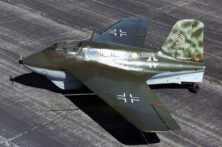
Messerschmitt Me 163 Komet https://nationalinterest.org/blog/the-buzz/the-super -scary-legend-nazi-germanys-me-163-rocketfighters-18494 Gedurende die 2de Wêreld Oorlog het Duitsland die Messerschmitt Me 163 Komet ontwerp, die enigste vuurpyl aangedrewe vegvliegtuig om operasionele diens te verrig. Dit was ontsettend
vinnig in vergelyking met enige ander vliegtuig gedurende die oorlog – die groot nadeel van die
vliegtuig was dat as dit raakgeskiet is, kon dit maklik ontplof agv die vuurpyl brandstof. Die ander nadeel was dat dit ontsettend vinnig sy brandstof verbruik het, in net 7 minute van vlug –met ʼn operasionele afstand van slegs 43.4 kpu. Dus is die Me 163 aangewend as verdedigende vegters by vliegvelde. Tiger Tenk 1 Die Tiger 1 van Duitsland, was ʼn groot swaar tenk wat diens gedoen het gedurende die 2de wêreld Oorlog. Met dik pantser en toegerus met ʼn 88mm kanon, was dit ʼn gevreesde opponent. Alhoewel dit effektief op die slagveld was, was dit moeilik om dit te onderhou en duur om te vervaardig. Die enorme gewig van die tenk het meegebring dat dit ontsettend baie brandstof verbruik het en was dit boonop baie moeilik om dit na die brandpunte te vervoer. Dr Stanley P Lovell https://www.archives.gov/research/military/ww2/ oss Die OSS se spioenasie en sabotasie operateurs het gereeld spesialis toerusting benodig. Generaal Donovan het dan ook kundiges, bymekaar gekry om werkswinkels aan te bied, en laboratoriums is deur die staat befonds. Die Navorsing en Ontwikkeling Tak is gestig en Dr Stanley P Lovell is as eerste hoof aangestel. Hierna is daar gereeld dwarsdeur die oorlog die Alliansie se wapens en

spioenasie toerusting voorsien, enkele voorbeelde was: pistole met knaldempers; liggewig masjiengewere; “Meano” handgranate wat op impak gedetoneer het; plofstof wat vermom is as steenkool; asetoon met vertraging lonte; kompasse wat in uniform knope verberg is; speelkaarte wat landkaarte verberg het; ‘n 16mm kamera in die vorm van ʼn vuurhoutjiedosie; smaaklose gif tablette; en sigarette wat ʼn ekstrak van die Indiese (hemp) bevat, wat
https://www.thoughtco.com/world-war-ii-tiger-i-tank -2361331 ongekontroleerde gesels uitgelok het.

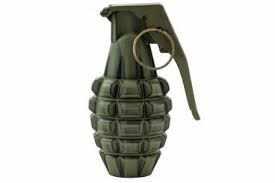
Meano Handgranaat (geprakseer om op inpak onmiddellik te detoneer) https://www.google.com/search? rlz=1C1JZAP_enZA855ZA856&sxsrf=ALeKk02_P y_glVnog_t57HCIMixnT1SkJg:1595091861481&s ource=univ&tbm=isch&q=world+war+2+meano+h
andgrenade=577

Speelkaarte wat landkaarte bevat het https://www.archivesgedruk.gov/research/military/ ww2/oss Die OSS het ook innoverende kommunikasie toerusting ontwikkel soos afluisterapparate, elektroniese bakens om agente op te spoor, draagbare radio’s wat kontak kon maak met vliegtuie, hetsy om teikens uit te identifiseer of om voorraad af te gooi. Dan het die OSS ook
vervalste Duitse en Japanse identiteitsdokumente, toegang bewyse en vervalste geld gedruk.
Die hoof van OSS, Dulles, het onafhanklike denkers gewerf, wat uit die boks kon dink. Hy is aangehaal waar hy opgemerk het: “ek kies eerder ʼn jong luitenant wat die durf het om ʼn direkte opdrag te ignoreer, as ʼn kolonel wat te rigied is om vir homself te dink.” Binne ʼn paar maande het hy ʼn organisasie tot stand gebring wat gelykstaande en daarna ʼn mededinger was van die Britte se Geheime Intelligensie Diens en SOE. Na die 2de wêreld oorlog, en na president Roosevelt se dood, het president Truman hom opgevolg en die OSS ontbind. Die State Departement het die Navorsing en Analise Tak oorgeneem en dit hernoem as die Buro vir Intelligensie en Navorsing; die Oorlog Departement het die Geheime Intelligensie Tak en Teen- Spioenasie Tak oorgeneem, en dit die Strategiese Dienste Eenheid genoem. In 1946, het president Truman die Eenheid Spesiale Operasies tot stand gebring en in 1947 die CIA gestig. Bronne: https://en.wikipedia.org/wiki/
den is granted permanent residenthe country since 2013
Fugitive US whistleblower Edward Snowden has been granted permanent residency in Russia after living in exile in the country since 2013, his lawyer Anatoly Kucherena said today. Russia.html Office_of_Strategic_Services https://www.archives.gov/research/military/ww2/ oss https://www.history.com/news/oss-thepredecessor-of-the-cia https://www.archives.gov/publications/ prologue/2002/spring/fritz-kolbe-1.html https://www.thoughtco.com/world-war-ii-tiger-itank-2361331 https://nationalinterest.org/blog/the-buzz/the-super -scary-legend-nazi-germanys-me-163-rocketfighters-18494 https://science.howstuffworks.com/messerschmittbf-109.htm https://www.google.com/search? rlz=1C1JZAP_enZA855ZA856&sxsrf=ALeKk02_P y_glVnog_t57HCIMixnT1SkJg:1595091861481&s ource=univ&tbm=isch&q=world+war+2+meano+h
https://www.dailymail.co.uk/news/article-8868257/ Snowden-granted-permanent-residencyandgrenade=577





